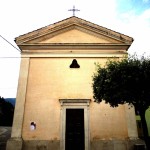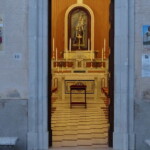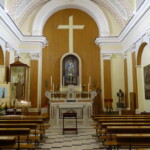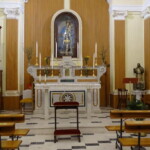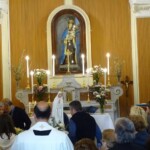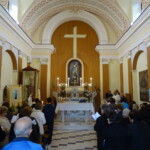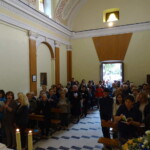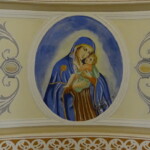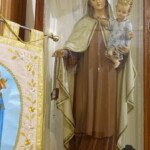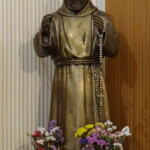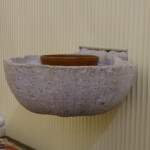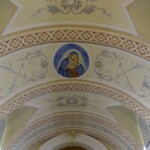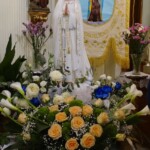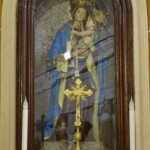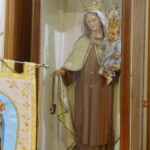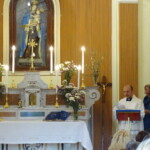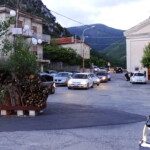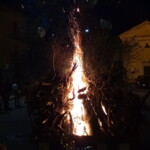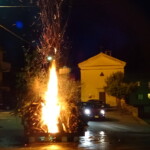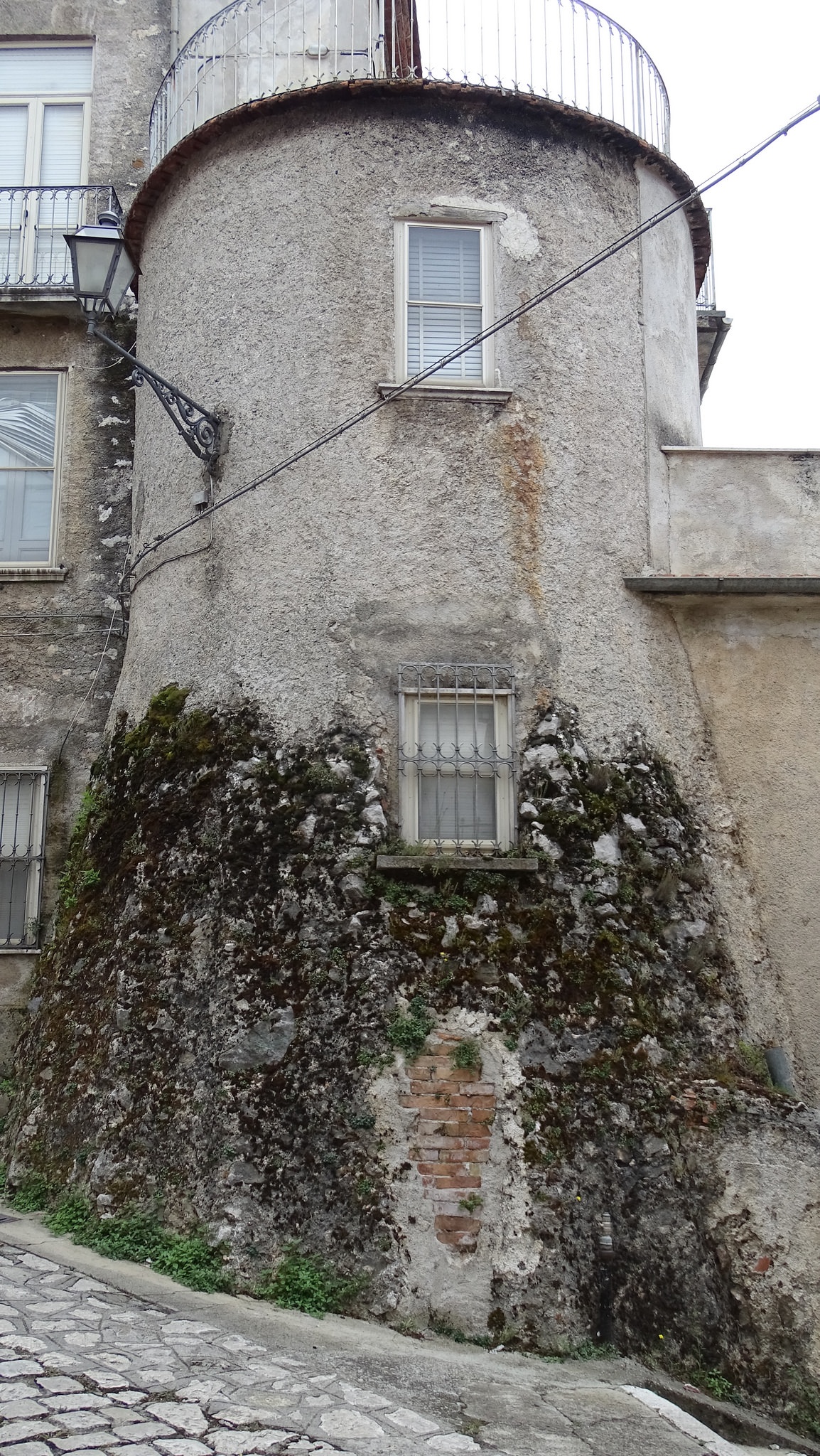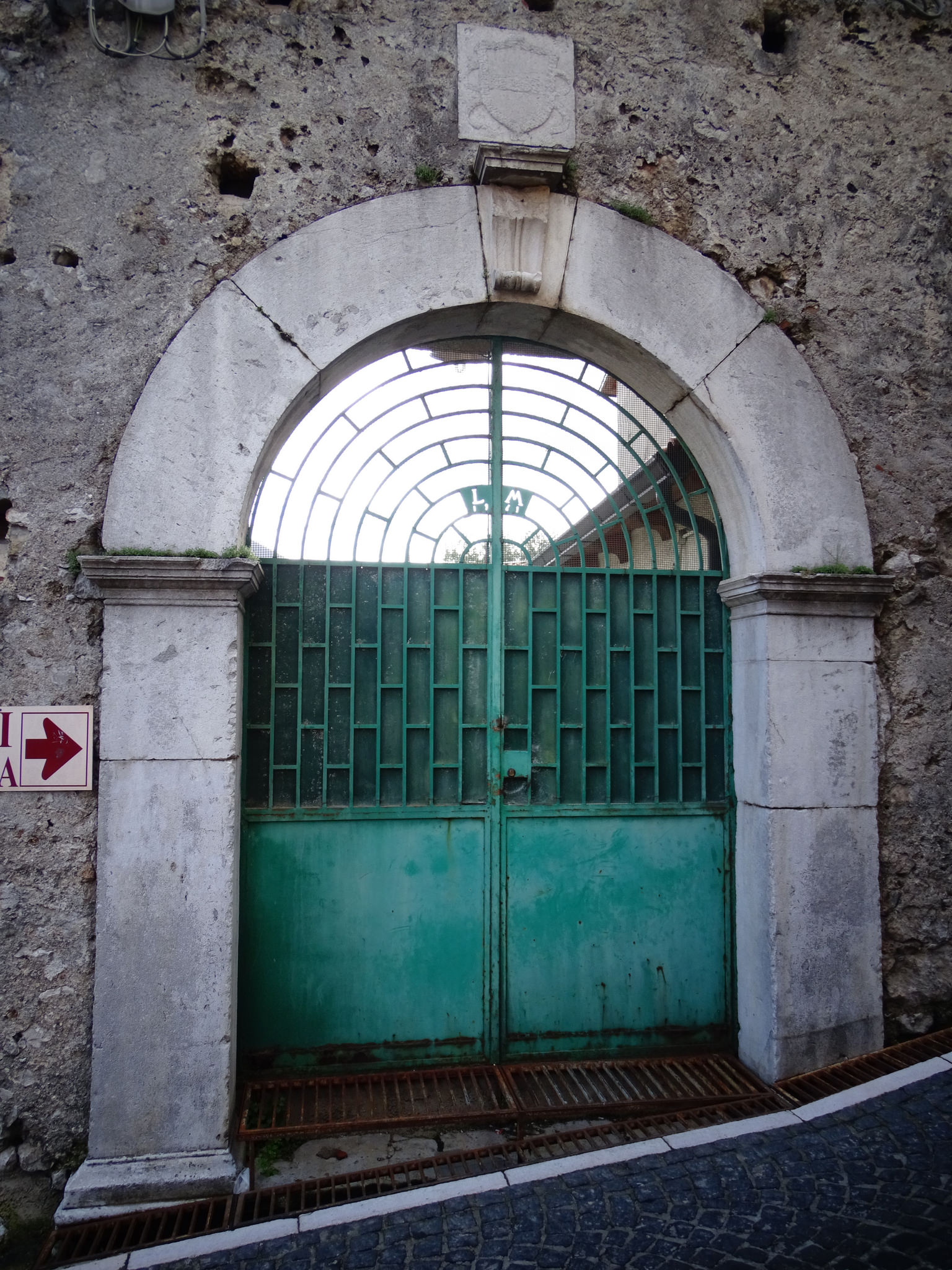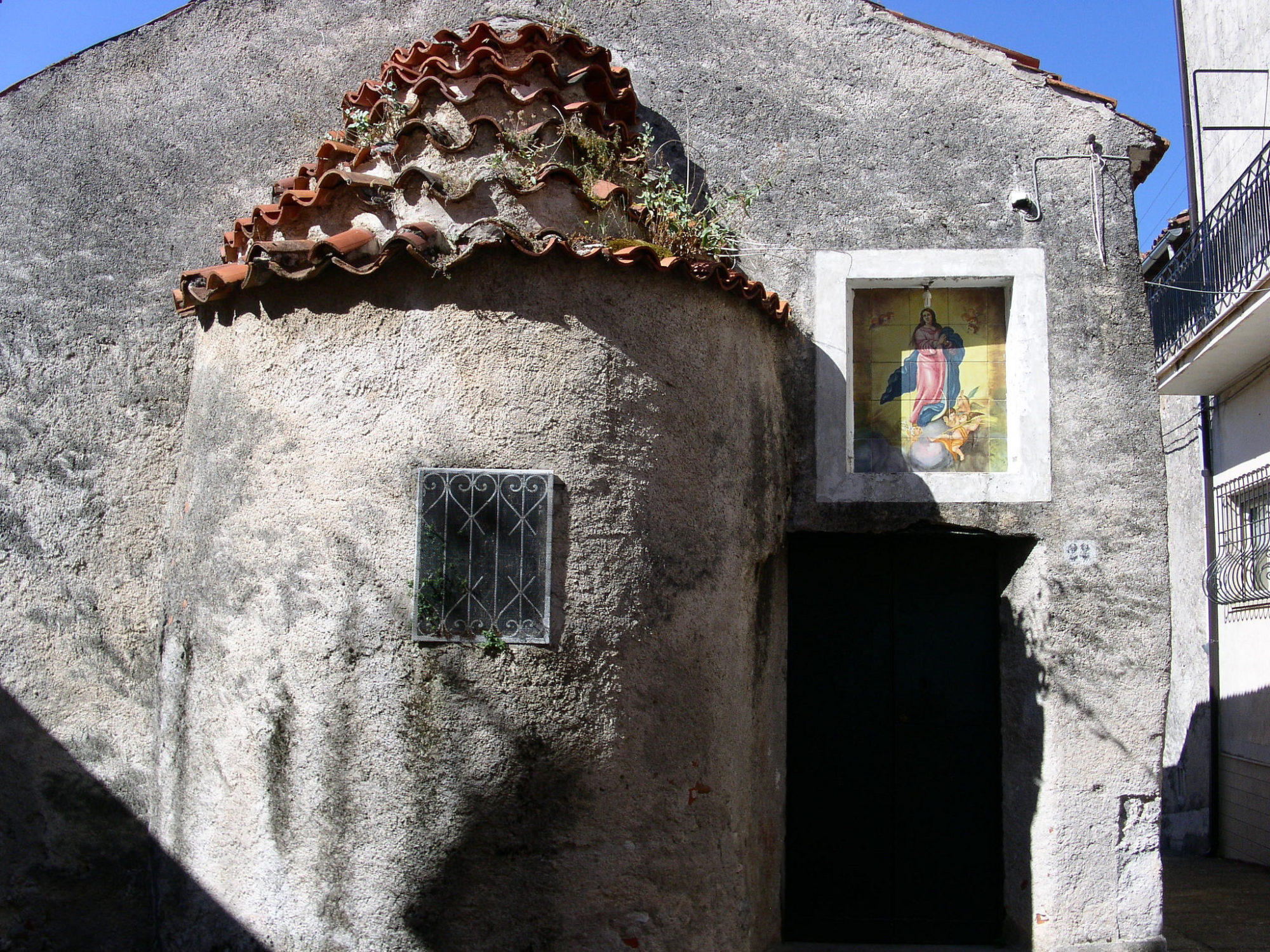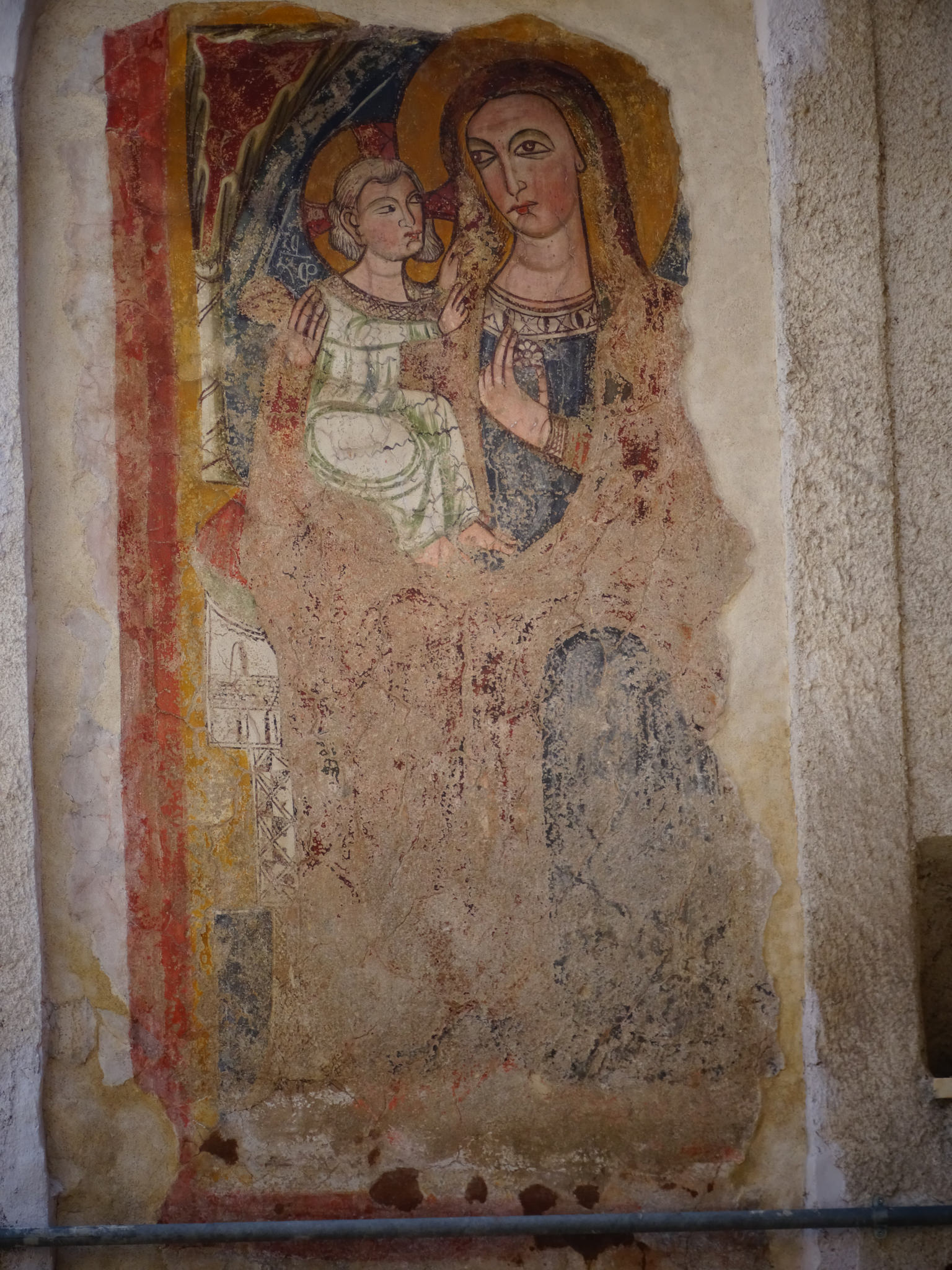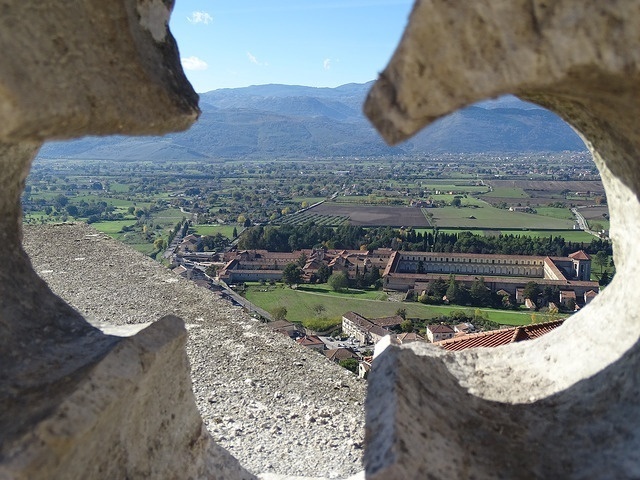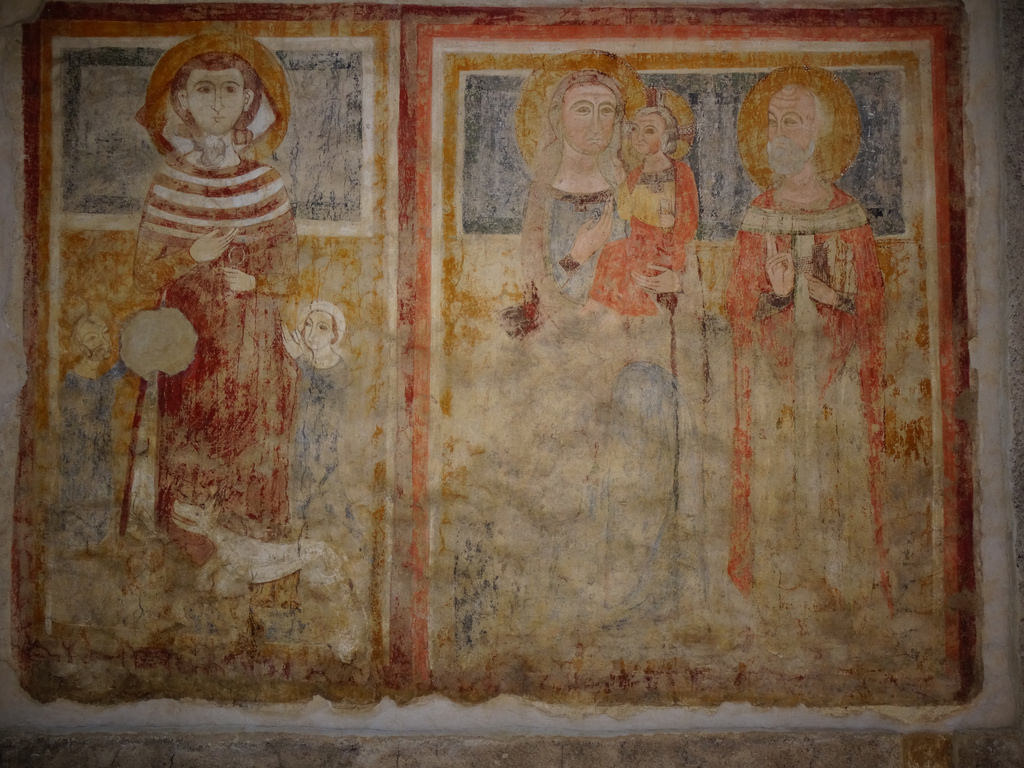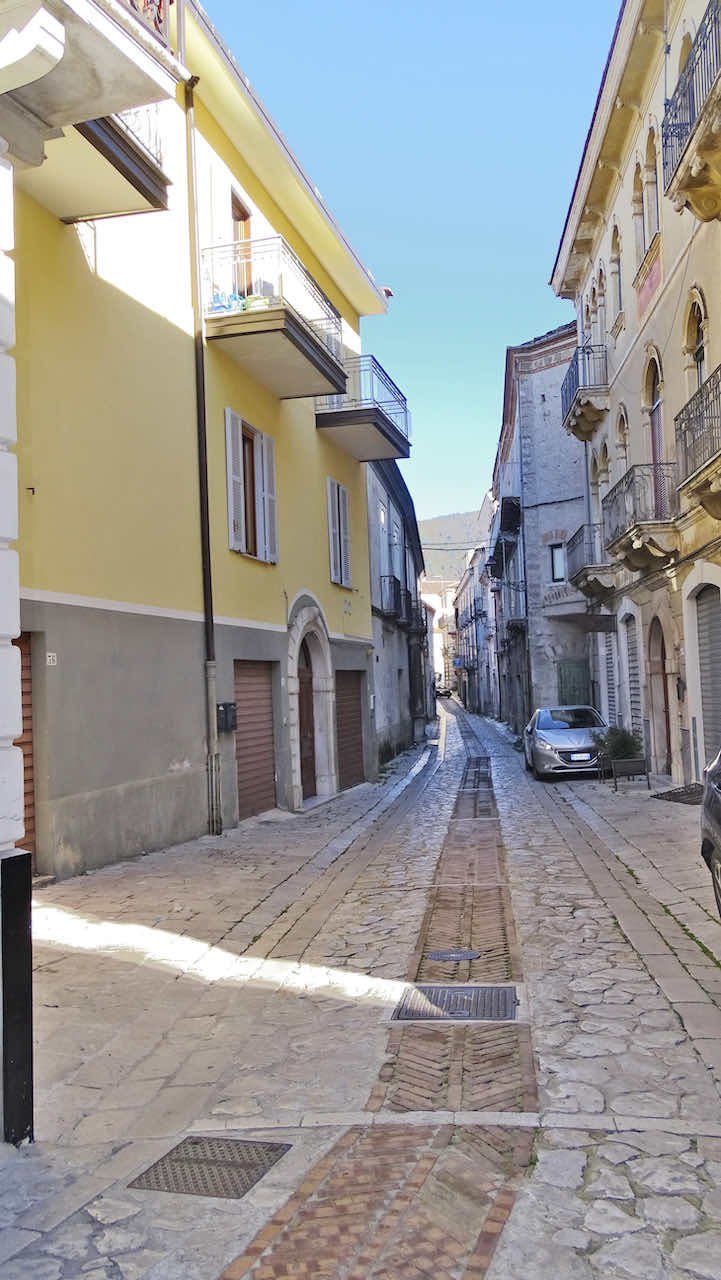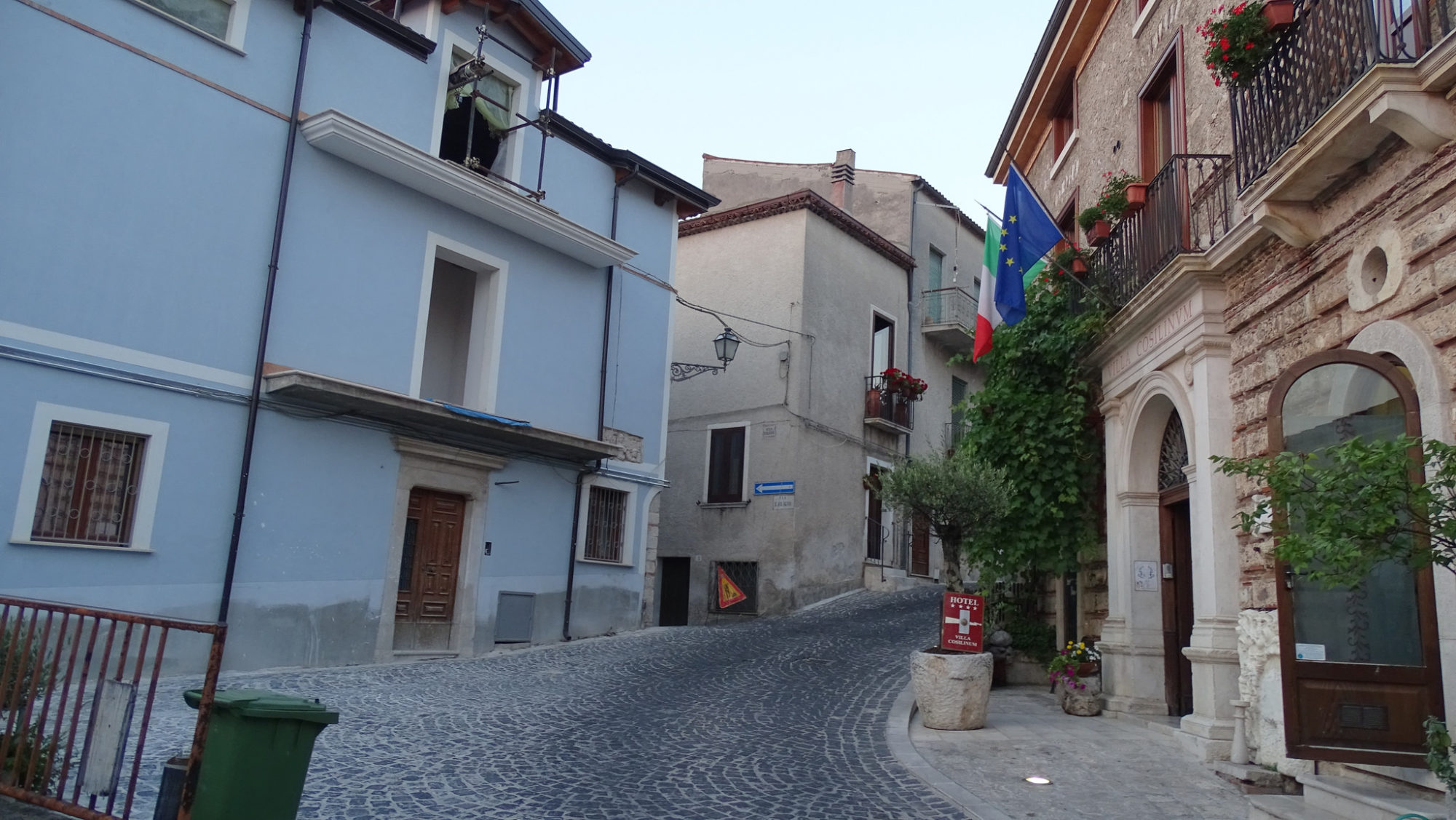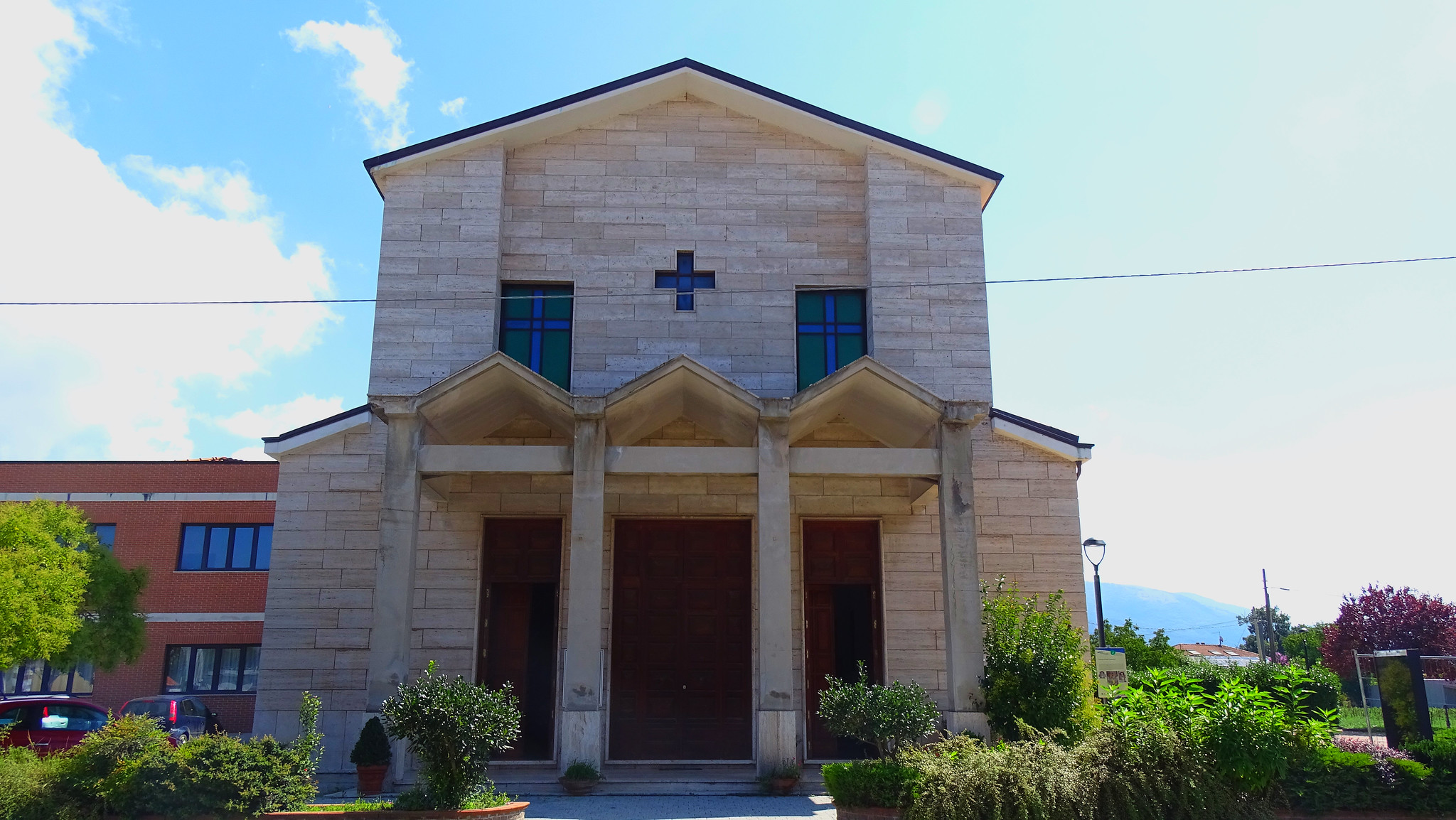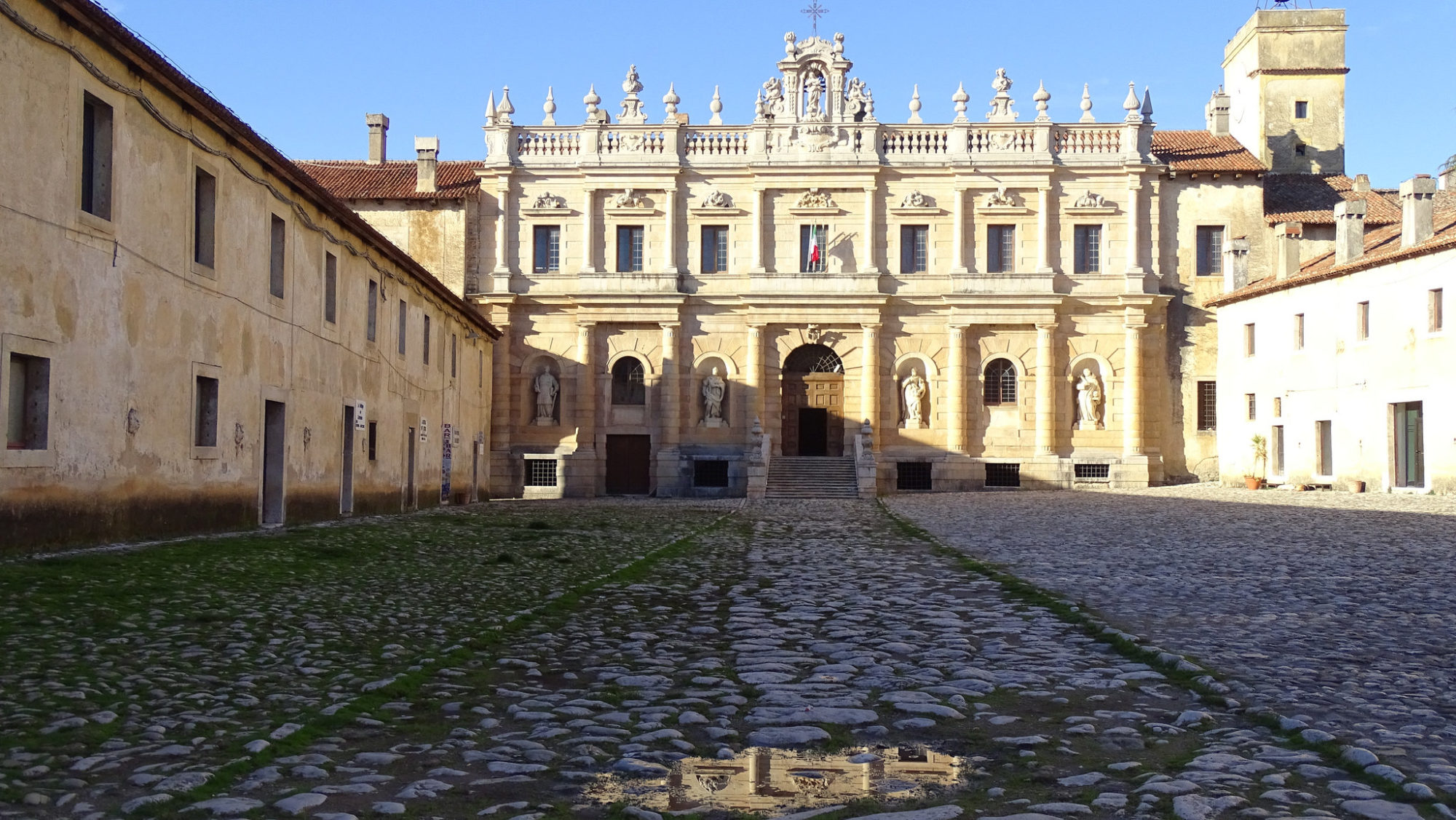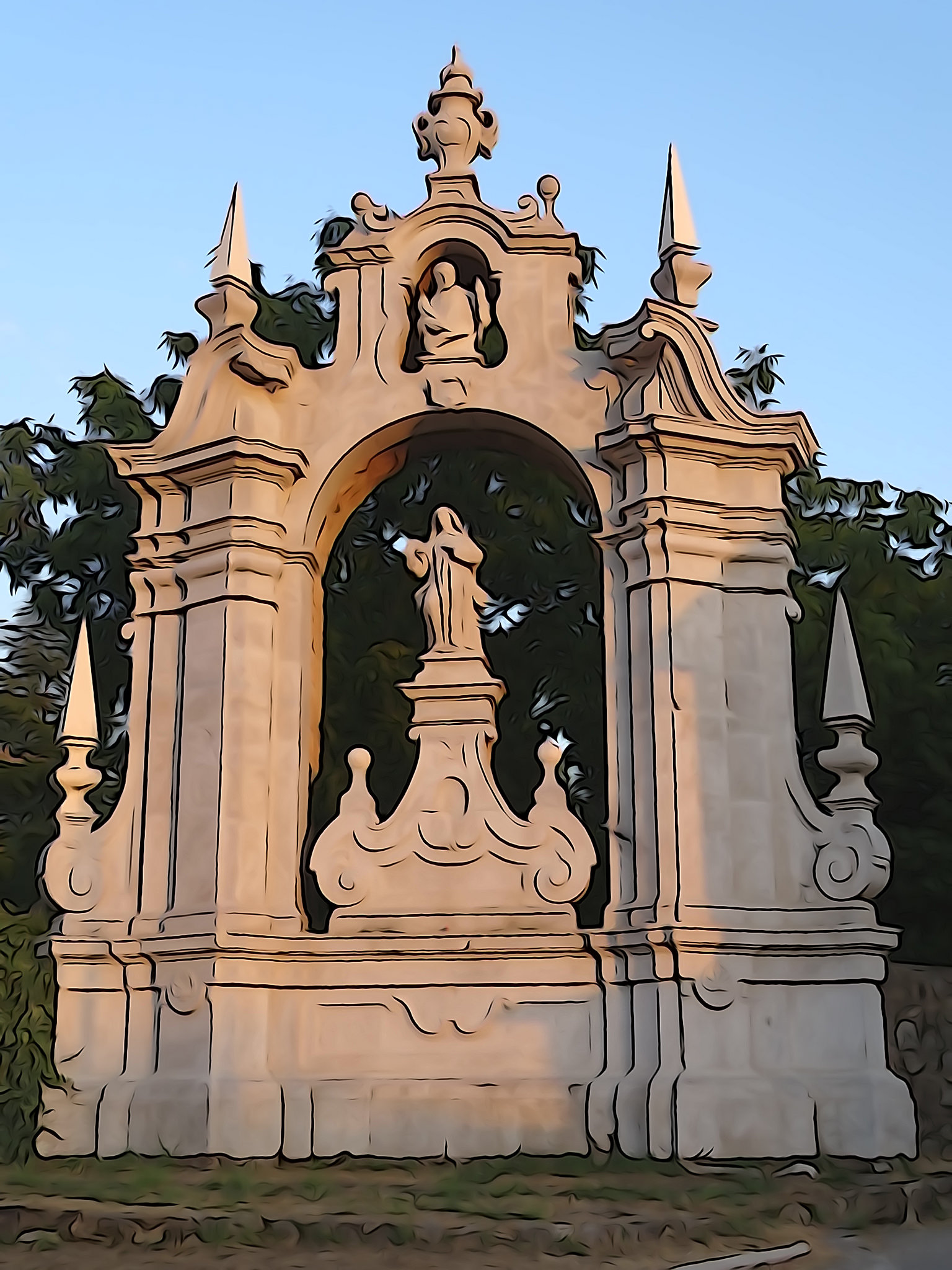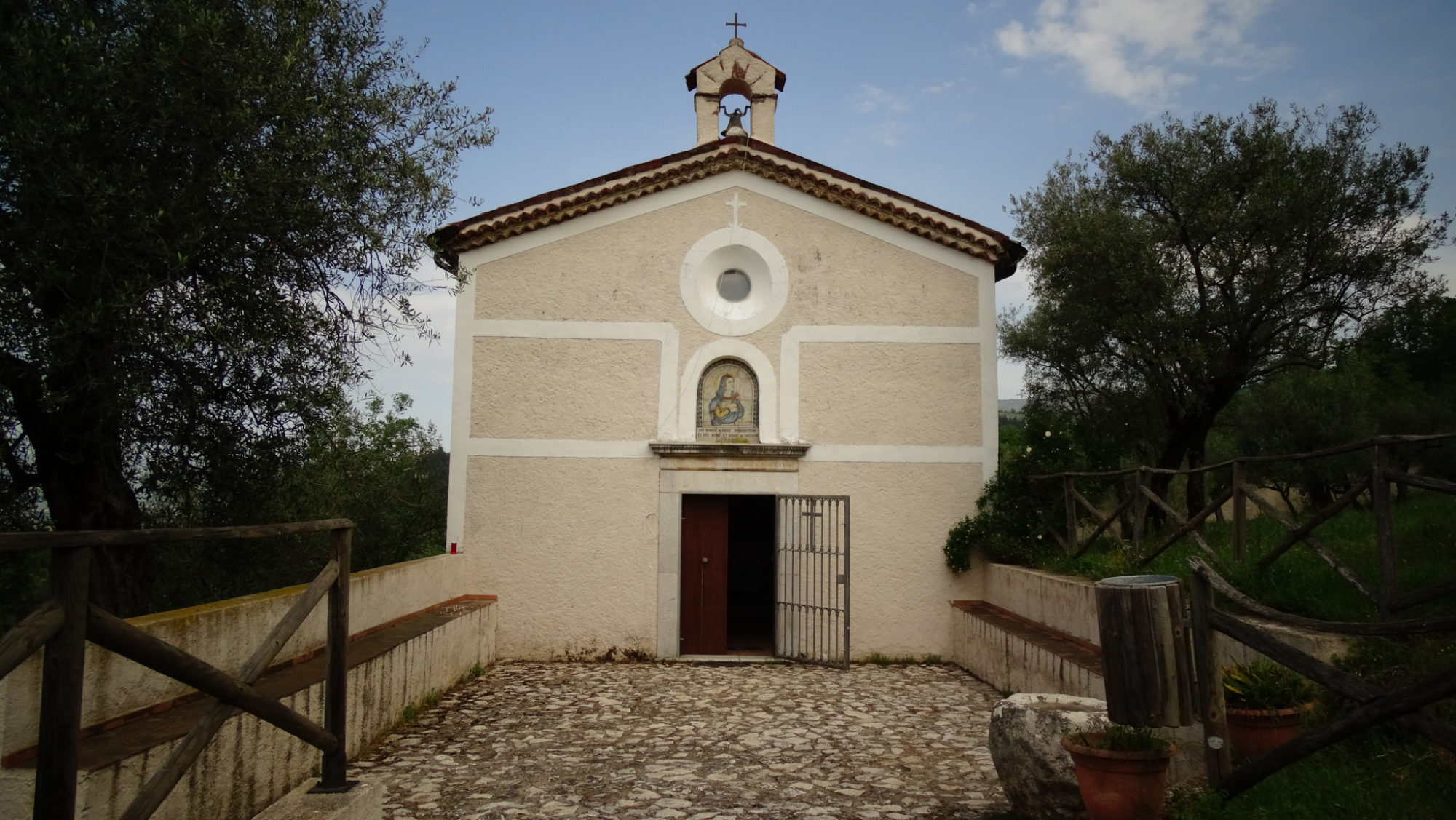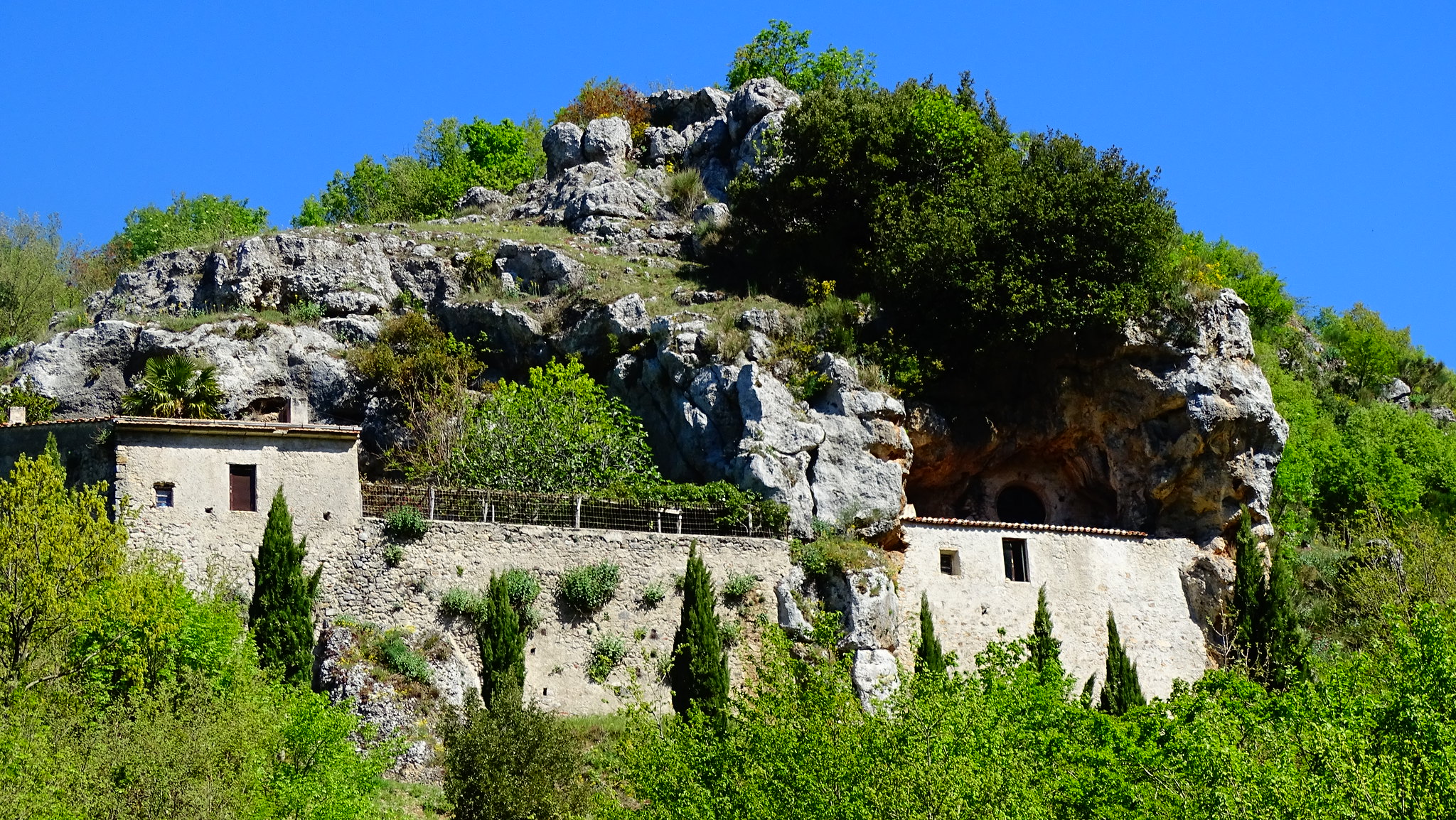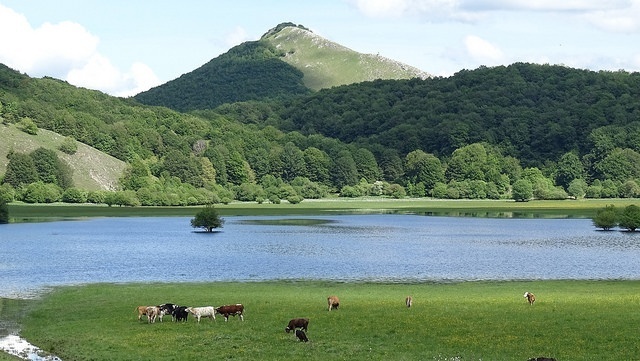Audioguide Itinerari
_⏬ 💒 01 Mad. del Carmine- 🇬🇧 EN
Madonna del Carmine chapel, a symbol of Padula’s faith and religion, is a place built for the nourishment of the soul. It’s located in the “Croce” town area and was built in the seventeenth century by Michele Moscarella near an ancient sacellum, in which “Beata Vergine del Monte Carmelo” was venerated. It has undergone profound changes which makes it nearly unrecognizable when compared to the original ancient structure. It has a rectangular plan, a single nave with a coffered ceiling, a pointed triumphal arch, a molded cornice on the entrance wall and an arch on the opposite wall. The church has a muted cabin front face, with a modest portal with stone architrave and jambs, surmounted by a semicircular window with three lobe openings which illuminate the internal environment. On the front face of the structure is a gabled porch, and on top of the roof, a double arch for the bells. In the back, there stands a small apse. The altar, embedded in the walling, is carved and inlaid polychrome marble, made by the people of Padula. In the center, there is a niche that contains the “Madonna del Carmine” ex-voto statue. In a wooden aedicule, on the left, there is a second “Madonna del Carmine” votive statue. Internally, the chapel is simple and solemn. The stuccoes and decorations are antient, and valuable. The vault is covered with a tempera decoration with plant and floral motifs. In the center, a fresco represents “Maria SS. Del Carmelo”. The small fan-shaped bell tower is located on the opposite wall of the church. Si ringrazia Samuel DeMuria per la traduzione
_⏬ 🏠 02 Palazzo Fam Romano 🇮🇹 IT - 🇬🇧 EN

 [expander_maker id=”1″ more=”Leggi la Storia
[expander_maker id=”1″ more=”Leggi la Storia 
La Storia
Palazzo Romano
Palazzo Romano era la residenza di Federico Romano, eroe e martire dell’olocausto di Carlo Pisacane. Nacque il 12 maggio 1814 e come tanti altri sostenitori di un’Italia unita ed indipendente, ricevette un’educazione a liberi sensi, grazie soprattutto allo zio Lorenzo, sacerdote di puri costumi, che sostenne i suoi studi. Provato dagli episodi di eroismo che lo zio ed altri uomini avevano messo in campo nel 1799 e nel 1820, contro le detestate dominazioni, fu sin da subito pronto a dare il suo contributo a favore degli oppressi.
Per un brevissimo periodo risultò iscritto anche alla Carboneria, insieme ad altri accesi liberali come Michele Netti e Raffaele Caolo.
Mentre poche decine di ardimentosi con Pisacane salpavano da Genova sul “Cagliari”, a Padula Federico Romano si organizzava all’imminente rivoluzione. La preparazione però era iniziata già da quando viveva a Napoli, periodo in cui era entrato in contatto con i liberali più in vista Giuseppe Fanelli e Giacinto Albini.
Quando, sull’imbrunire del 30 giugno 1857, arrivò quasi inattesa a Padula la stremata e disperata legione di Sapri, si diresse subito al palazzo del Romano, già designato come sede del Comando, e si accampò col Falcone e col Nicotera sul piazzale Croce (oggi Largo 1 Luglio) sperando di trovare uomini già pronti ed armati, giacché il Fanelli aveva fatto intendere al Pisacane che s’era accordato col Romano; invece ben presto si accorse che gli abitanti erano atterriti e disorganizzati. Trovò soltanto i fratelli Santelmo, Federico Romano e pochi altri cospiratori. Adunatili in casa Romano insieme al sindaco e al giudice supplente parlò loro, facendo conoscere l’urgenza di armarsi, sperando che da un momento all’altro comparissero almeno alcuni dei compagni coi quali era stato in corrispondenza.
L’alba del 1 luglio trova Padula occupata da un nucleo di soldati nemici. Una lotta micidiale, che dura circa mezz’ora e porta al primo massacro. Ma ben altro e più agguerrito numero di borbonici affrontava i nostri, che, vistisi perduti, indarno invocanti la pace in nome della Patria comune e della libertà, o caddero con le armi in pugno o furono trucidati in un vicolo cieco ed ammucchiati come inutile carname.
Le tenebre della sera scendevano a coprire il terribile eccidio, mentre i pochi superstiti spiegavano il vessillo tricolore al grido d’Italia, avviandosi alla volta del Cilento.
Dopo questa strage, il palazzo Romano fu saccheggiato ed incendiato e la famiglia si salvò disertando. Parecchi sospetti caddero sul Romano. Tra le altre accuse mossegli vi fu quella di avere scritto finanche i proclami nel paese e nei dintorni in numero rilevante di copie, per cui fu inesorabilmente perseguitato. Egli intuì tutto e si rese latitante, rifugiandosi alla meglio fino ai primi del ’59 a rincasare. Fu piantonato in casa dalle guardie e, per giunta, l’estrema agonia del martire fu funestata dalla presenza dei poliziotti feroci e spietati, che gli proibirono perfino di esprimere le ultime volontà e di rivolgere una parola ai familiari desolati. Morì il 18 marzo 1859. [/expander_maker]
[expander_maker id=”3″ more=”read the story 
Palazzo Romano.
Romano Palace
Residence of Federico Romano, hero of the Pisacane expedition. Born on 12.05.1814, he was educated by the uncle Lorenzo, a liberal priest that teached him about the ideals of freedom and independence for Italy. Excited by the examples of his uncle and other local liberals in the 1799 and 1820 insurrections, he associated himself with the Carboneria secret society, along with Michele Netti and Raffaele Caolo.
As Pisacane with his men landed in Sapri, Federico romano was busy preparing the insurrection, thanks to the connections he has acquired during his stay in Naples, especially with the leading liberals figures Giuseppe Fanelli and Giacinto Albini.
But When Pisacane arrived in Padula, only a few men were ready to associate with Federico Romano, because the population stayed away from the patriots.On july 1st, the royal troops occupied Padula, killing most of the patriots , only few of them managing to escape towards the Cilento .
The Palace Romano was sacked and put on fire. Federico Romano had to flee but managed to come home in 1859, however he was kept under strict police surveillance , that didn’t allow even on the deathbed to have his relatives visiting him. He died 18 March 1859.
[/expander_maker]
_⏬ 💒 03 S. Maria Costantinopoli 🇮🇹 IT - 🇬🇧 EN
[expander_maker id=”1″ more=”Leggi la Storia 🇮🇹 IT ” less=”Torna Su”]
La Storia
Cappella di Santa Maria di Costantinopoli
Fondata dalla famiglia Romano di fronte al palazzo ereditato, essa è datata 1772, come si legge sul portale di ingresso. Questo è sollevato di quattro scalini rispetto al livello stradale e presenta un portale in pietra ben lavorato. Una piccola campana è ospitata in cima alla facciata in un campanile di modeste dimensioni, anch’esso in pietra. L’aula di forma rettangolare è illuminata da un finestrone trilobato ed arricchita da decorazioni in stucco. Sull’altare in pietra locale è situata una tavola in legno raffigurante la Madonna di Costantinopoli.
[/expander_maker]
[expander_maker id=”3″ more=”read the story 
Cappella S. Maria di Costantinopoli
Chapel St. Mary of Constantinople
The chapel was founded in 1772 as inscribed on the portal by the Romano familyon a site facing their mansion. A 4 stairs staircase leads to the richly decorated stone portal. A small clocktower in stone crowns the roof. The rectangular shaped interior is illuminated by a trilobite window and has stuccoed decorations. On the altar made from local stone there is a portrait of the Costantinopel Madonna.
[/expander_maker]
_⏬ 🏛 04 Torri Angioine 🇮🇹 IT - 🇬🇧 EN
[expander_maker id=”1″ more=”Leggi la Storia 🇮🇹 IT ” less=”Torna Su”]
La Storia
Torri angioine
L’analisi stilistica e costruttiva delle torri della cinta muraria, cilindriche con scarpata scanalata con un paramento murario in pietra calcarea, consentono di classificarle come “angioine”. Furono questi, infatti, che alla fine del XIII sec. importarono in Campania la torre cilindrica scarpata, alta, di grosso spessore, coronata di beccatelli quale si era avuta in alcune realizzazioni francesi. Torri analoghe a quelle di Padula sono a Castelcivita (1280) e le torri cilindriche della cortina angioina di Capaccio vecchia; furono proprio i Sanseverino a realizzare nell’area cilentana uno dei più importanti esempi di tale fattura: la torre sull’acropoli magnogreca di Velia, databile tra la fine del XIII e l’inizio del XVI sec.
[/expander_maker]
[expander_maker id=”3″ more=”read the story 
Torri Angioine
Angevin towers
The round form and the channelled escarpment, reinforced by calcareous stone ,are all inducive for the towers to classify them as belonging to the Anjou dynasty time on the throne of Naples. The style of smaller towers was in fact imported from France where the Angevin kings came from. Similar tower may be seen in Castelcivita, Capaccio and on the Greek ruins of Velia built by the Sanseverino family the lords of the area that today is the Salerno province.
[/expander_maker]
_⏬ 🏚 05 Casa Padula 🇮🇹 IT - 🇬🇧 EN
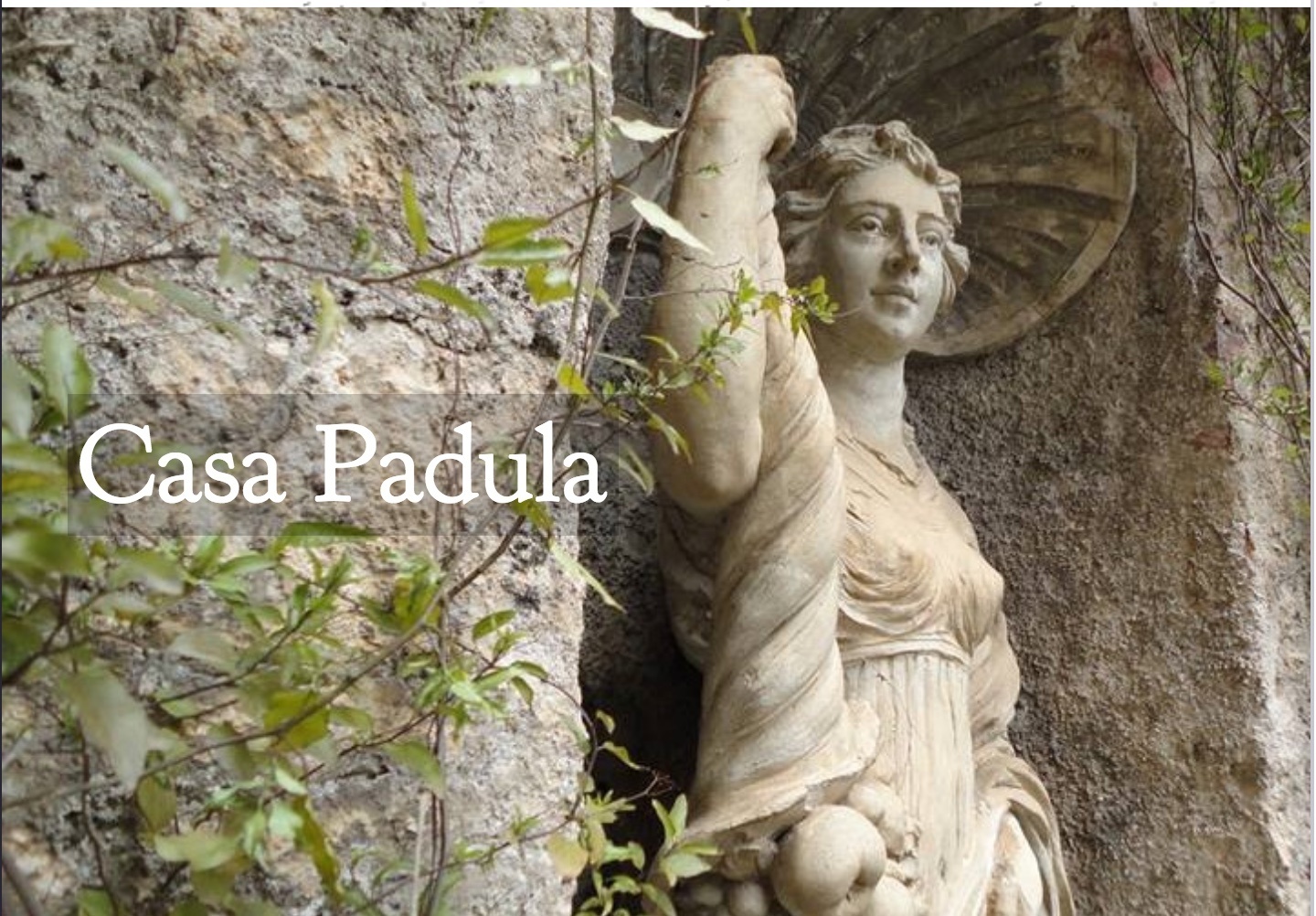
Casa Padula
[expander_maker id=”1″ more=”Leggi la Storia 🇮🇹 IT ” less=”Torna Su”]
La Storia
CASA PADULA
Varie epoche storiche hanno lasciato la loro impronta su Casa Padula.
Iniziando dal Medioevo, essendo le mura della casa costruite sulle difese esterne del castello di Padula, così da raggiungere in alcuni punti uno spessore fino a 1,5 m. Poi il Settecento, a cui si ispira la decorazione , della camera da pranzo, e l’Ottocento, secolo agitato, con cospiratori, rivoluzionari e poi briganti, durante il quale la casa si dota di feritoie per rafforzare un’eventuale difesa armata.
Nel primo Novecento, infine, la casa è la prima nel paese a dotarsi di un sistema di riscaldamento a carbone, alimentato da una grande stufa.
Di antica tradizione liberale, la famiglia Padula fu impegnata in prima linea nel Risorgimento italiano. Vincenzo Padula, sacerdote di sentimenti liberali, fu tra gli organizzatori dell’insurrezione nazionale nel Salernitano, raccogliendo le armi in luoghi sicuri e tenendo i contatti con gli altri patrioti della provincia e con quelli della contigua Basilicata. Ma Vincenzo Padula venne arrestato dalla polizia borbonica, e la sua assenza disanimò i patrioti locali contribuendo al fallimento della Spedizione organizzata da Carlo Pisacane per sollevare la popolazione contro la monarchia dei Borboni, e che proprio nei vicoli di Padula venne sanguinosamente dispersa dalle truppe regolari . Dopo due anni di prigionia, Vincenzo Padula venne esiliato a Genova dove entrò in contatto con Garibaldi, e partì con i primi Mille che il 5 maggio 1860 si imbarcarono da Quarto alla volta della Sicilia. Dopo la sbarco a Marsala, Vincenzo combattè valorosamente a Calatafimi e Palermo, dove venne promosso capitano. Ma nella successiva battaglia davanti la fortezza borbonica di Milazzo venne mortalmente ferito e spirò poco dopo, a soli 28 anni.
Il più giovane fratello di Vincenzo, Filomeno, fu anche lui garibaldino e poi, dopo l’Unità d’Italia, capitano della Guardia Nazionale di Padula. Il reparto fu a lungo impegnato, accanto all’esercito italiano , nella lotta al brigantaggio che in quegli anni aveva assunto dimensioni particolarmente estese.
Filomeno si distinse in particolare nell’uccisione del brigante Masini, uno dei principali che operavano sui monti della Basilicata. Il Masini venne attirato con pochi suoi fidi in una trappola e Filomeno Padula lo affrontò con un pugno di uomini riuscendo a sopraffarlo il 20 dicembre 1864.
Per questa azione Filomeno venne decorato con la medaglia d’argento al valor militare. Svolse successivamente attivita’ politica a livello locale, come riferimento di Giovanni Nicotera, esponente della Sinistra ed ex compagno di Pisacane .
La Casa con l’annesso giardino viene oggi messa a disposizione per ricevimenti , eventi e brevi soggiorni.
[/expander_maker]
[expander_maker id=”3″ more=”read the story 
Casa Padula
The Padula family was at the center of local the movement for National Unity and liberal reforms. Vincenzo Padula was part of the network that planned the insurrection in connection with the landing of Carlo Pisacane in 1857.However, his arrest on the eve of the expedition was a strong blow for the liberal movement, and contributed to the failure of the initiative.
Vincenzo died later fighting under Garibaldi’s command in Sicily (1860) while his brother Filomeno was captain of the local National Guard, engaged in the repression of brigandage.
The Casa with the garden is rented for events.
[/expander_maker]
_⏬ 💒 06 S. Clemente 🇮🇹 IT - 🇬🇧 EN

S. Clemente
[expander_maker id=”1″ more=”Leggi la Storia 🇮🇹 IT ” less=”Torna Su”]
La Storia
Chiesa di San Clemente
Di fondazione duecentesca la chiesa di San Clemente si trova ai piedi dell’antico sito del castello. Era la parrocchia dei signori di Padula che lì si recavano per “vedere la messa”. Scarse le notizie e i documenti che ne tracciano la storia; sappiamo solo che nella metà del Seicento alla chiesa risultavano annessi un ospedale di proprietà della Terra e un luogo di sepoltura e che agli albori del XX secolo essa era già stata ampiamente trasformata e ricostruita in più parti, forse a causa dei danni causati dal terremoto del 1857. Di sicuro, crollato il soffitto piano dell’aula, ne fu costruito uno nuovo con una volta a botte e in più si aggiunse un nuovo corpo di fabbrica verso la Piazza per ricavarne i due ingressi attuali. L’ingresso principale, inquadrato da un portale architravato, collocato in asse con la fuga di Via XX Settembre, determina la particolarità di permettere l’accesso all’aula nella sua parte centrale. Originariamente, invece, l’ingresso era sul lato ovest in asse con la navata. La chiesa, quindi, è a navata unica di forma rettangolare ed è illuminata da cinque finestroni a tutto sesto. Un arco trionfale inquadra l’altare maggiore alle cui spalle si sviluppano gli ampi locali della sacrestia, attraverso i quali si accede al campanile e ai due matronei posti ai due lati dell’altare. Quello di sinistra è collegato al corridoio del campanile dove a sua volta si apriva l’ingresso utilizzato dai signori di Padula che passavano così direttamente dal giardino del castello al matroneo. L’altare maggiore, sollevato di tre scalini rispetto al piano dell’aula, è in pietra e marmi policromi. Sopra di esso una edicola in legno dorato e vetro ospita la statua in gesso della Madonna del Rosario. Il campanile, in muratura di pietrame a vista, si sviluppa su tre ordini; i primi due sono a sezione quadrata, il terzo è di forma poligonale.
[/expander_maker]
[expander_maker id=”3″ more=”read the story 
Chiesa S. Clemente
St. Clemente church
Founded in the XIII century, attached to the castle, it was the church of the Padula lords that went to the chirch for Mass. According to the few documents available, In the XVII century there was a hospital and a cementery next to the church. The present church is the result of renovations implemented especially afyter the 1857 earthquake. Originally the entrance was in line with the main nave, the present entrance is a later transformation. There is only one nave, that ends with the altar beyond a triumphal arch. On the left was a balcony where the lords could assist to the liturgy. The altar is made pf local stone and marble, and supports a statue of the Madonna del Rosario inside a wooden case.
[/expander_maker]
_⏬ 🏛 08 Museo Civico 🇮🇹 IT - 🇬🇧 EN
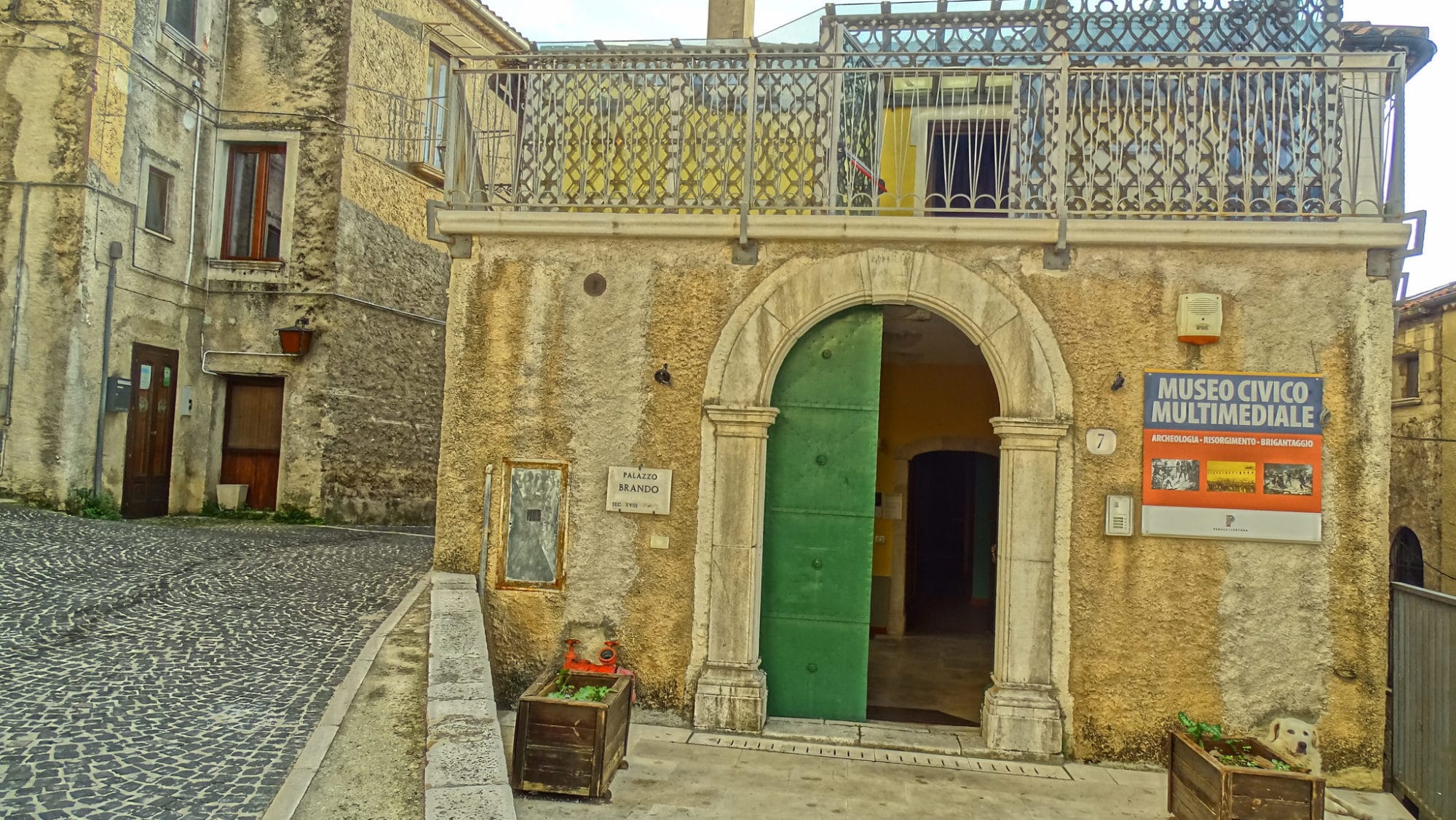
[expander_maker id=”1″ more=”Leggi la Storia 🇮🇹 IT ” less=”Torna Su”]
La Storia
Museo Civico Multimediale di Padula
Il Museo Civico Multimediale di Padula è allestito all’interno dell’antico Palazzo Brando ed è dedicato all’archeologia e alla storia antica del Vallo di Diano nonché alla fase dei moti risorgimentali. Padula fu tra i principali protagonisti di tali moti reazionari con la Spedizione dei Trecento condotta dal patriota napoletano Carlo Pisacane nel 1857. Il museo consente di conoscere la nostra storia attraverso cassetti ed armadi parlanti, burattini interattivi e prevede la partecipazione attiva, al termine del percorso, al processo a Carlo Pisacane con un giudice virtuale che interroga vari testimoni. Nel museo è possibile assistere alla ricostruzione, attraverso documenti d’archivio, di tante microstorie locali all’interno della più ampia macro storia del brigantaggio post-unitario.
[/expander_maker]
[expander_maker id=”3″ more=”read the story 
Museo civico multimediale
Multimedia Civic Museum
The Museeum is housed in the former Brsando Palace , and has sections devoted to archaeology, ancient history of the Diano Valley and the period of the struggle for Italian National Unity, as Padula was the site where the Carlo Pisacane expedition found its tragic end. The Museum has an interactive program where an imaginary process to Carlo Pisacane is screened. The private life of families of the area is accessible through reproduction of archive documents.
[/expander_maker]
_⏬ 🏛 09 Museo del Cognome 🇮🇹 IT - 🇬🇧 EN
Museo del cognome
[expander_maker id=”1″ more=”Leggi la Storia 🇮🇹 IT ” less=”Torna Su”]
La Storia
Museo del Cognome
Ambientato al piano terra di una casa del 1700 nel centro storico di Padula, il Museo del Cognome è unico al mondo nel suo genere. Di stampo prevalentemente didattico, prevede, al suo interno, un percorso appositamente creato per aiutare il visitatore a muovere i primi passi nella ricerca genealogica. E’ diviso in tre sezioni; la prima sezione riguarda “Il cognome e la ricerca genealogica”, è improntata sulla storia del cognome, il cognome nel mondo e di come muovere i primi passi per poter affrontare una ricerca genealogica e ricostruire il proprio albero. Dai documenti affissi alle pareti, come atti di nascita, morte, matrimoni, liste di leve, censimenti e atti notarili, viene fuori quella che è la storia di ognuno di noi. La seconda sezione è una panoramica sull’emigrazione italiana nel mondo. Il visitatore si ritroverà affacciato, attraverso le liste d’imbarco, alla balaustra di una nave dell’800 come realmente successo all’antenato, che noi definiamo lo “Zio d’America”. Con un po’ di attenzione e con un minimo di conoscenza della lingua inglese il visitatore potrà affrontare la grafia degli addetti alla trascrizione delle richieste di passaporti, naturalizzazioni, iscrizioni alla prima e seconda guerra mondiale. I documenti più belli sono i censimenti che ci danno uno spaccato di vita italiana nell’America di inizio ‘900. In una piccola stanzetta adiacente, vi è una bella mostra di foto e documenti antichi per la maggior parte donati da discendenti di italiani all’estero. La terza sezione, inaugurata all’inizio del 2014, vede in mostra documenti di alberi genealogici di personaggi illustri. Ci sono l’atto di nascita di San Giuseppe Moscati e di Benito Mussolini, troviamo la nascita di Luigi Pirandelli (il famoso scrittore italiano a cui alla nascita fu erroneamente sbagliato il cognome e venne corretto solo dopo 30 anni). Alberi genealogici di attori e cantanti come De Niro e Sinatra di origine italiana. La particolarità, poi, di Silvester Stallone che porta lo stesso nome Silvestro riferito a un antenato nato a Palo del Colle (Bari) nella prima metà del 1700.
[/expander_maker][expander_maker id=”3″ more=”read the story 
Museo del Cognome.
The surname’s Museum
This is a unique Museum that has the aim of introducing the visitor to genealogical research. In the first section there is an overview of the history of surnames through ancient documents and birth certificates. The second section traces the history of Italian emigration overseas, especially in the USA. The third section shows family trees of famous people , among them Hollywood actors with Italian roots.
[/expander_maker]
_⏬ 💒 10 S. Agostino e mostra presepi 🇮🇹 IT - 🇬🇧 EN
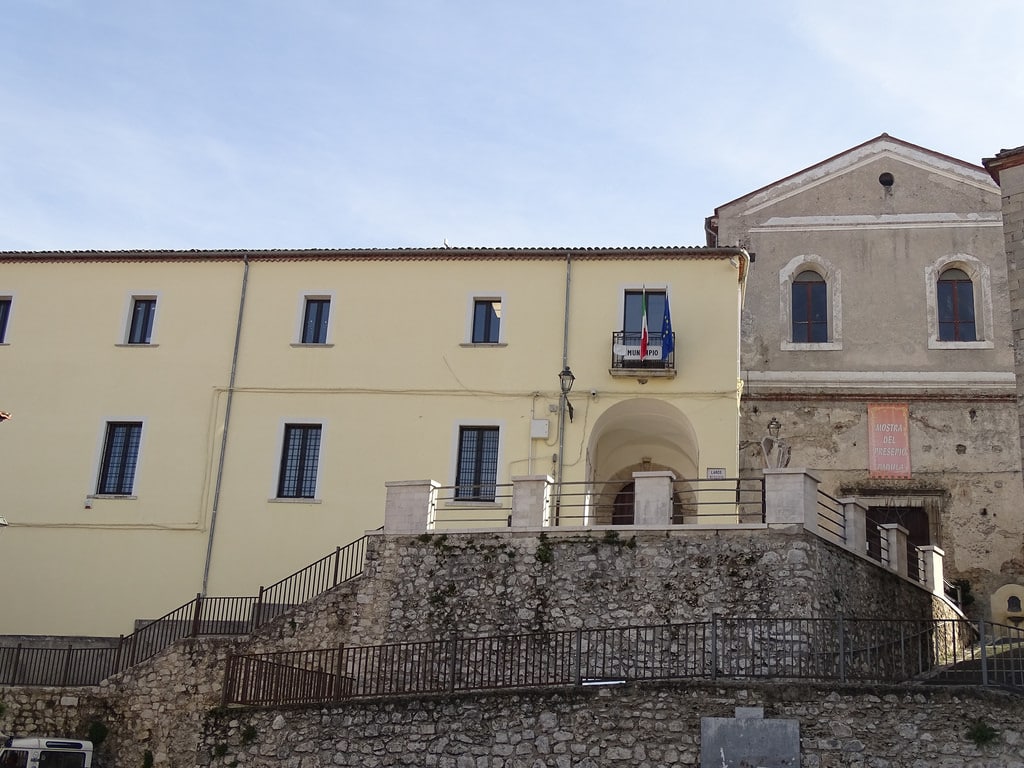
Convento S. Agostino
 [expander_maker id=”1″ more=”Leggi la Storia
[expander_maker id=”1″ more=”Leggi la Storia 
La Storia
Convento di Sant’Agostino e Mostra presepi.
Il convento di Sant’Agostino è stato fondato nel XIV secolo in luogo di un’antica chiesa intitolata a San Matteo. Fu voluto dai nobili Sanseverino, in onore dei quali i monaci agostiniani erano tenuti a celebrare otto messe settimanali. Poco distante dalla chiesa madre di Sant’Angelo, era considerato il convento più ricco e importante dopo la Certosa di San Lorenzo ed infatti possedeva diversi beni al di fuori della terra di Padula e, nel XIV secolo, aveva entrate pari a 400 ducati l’anno. Agli inizi dell’Ottocento il convento fu soppresso a seguito delle leggi eversive emanate dal governo napoleonico e nel 1819 la parte conventuale passò definitivamente sotto la giurisdizione del Comune, ospitandone gli uffici, la caserma dei carabinieri, il carcere e le scuole pubbliche. La presenza di questi servizi, se da una parte ha contribuito a conservare meglio un edificio imponente ormai abbandonato, dall’altra è stata causa di modifiche ed alterazioni alla stessa struttura architettonica dell’intero complesso. E’ il caso, tanto per fare l’esempio, della zona sovrastante il chiostro dove sono state murate due finestre ed una terza trasformata in balcone. La chiesa ha una facciata piuttosto semplice, divisa in due ordini. Nella parte alta si aprono due ampi finestroni con arco a tutto sesto, incorniciati da una fascia di intonaco liscio. In basso, sollevato da una gradonata rispetto al piano stradale, si apre l’ingresso inquadrato da un portale in pietra di fattura quattrocentesca. Nell’interno, subito dopo l’ingresso, una struttura muraria a mo’ di palco sorregge il settecentesco organo a canne, ormai irrecuperabile. L’aula, di forma rettangolare, ospita sulle pareti laterali, all’interno dello spessore murario, quattro altari con relative nicchie. In fondo è il presbiterio sollevato di due scalini rispetto al piano dell’aula, con l’altare maggiore collocato al centro. Un’abside di forma semicircolare è incorporata nelle strutture perimetrali, mentre la sacrestia era ospitata in un piccolo ambiente a destra dell’altare maggiore. Un’altra piccola sala a destra dell’ingresso ospitava forse la fonte battesimale; la volta a crociera appare molto danneggiata dal crollo della copertura mentre dell’altare della cappella, distrutto o asportato, rimane un affresco raffigurante la deposizione del Cristo posto al di sotto del piano della mensa. Attraverso una porticina si accede al campanile, opera pregevole che all’esterno si presenta a sezione quadrata mentre all’interno ha forma perfettamente circolare. Realizzato in muratura di pietrame, ha tre ordini di ballatoi in legno ai quali si accedeva da una scala anch’essa di legno, con le campane, due piccole ed una grande, alloggiate sul ballatoio più alto. L’aula infine, presenta decorazioni e modanature di semplice fattura ottocentesca, realizzate in stucco e muratura. Passando al chiostro del convento, si evidenzia che esso costituisce l’elemento principale dal punto di vista architettonico nonché l’opera più suggestiva del complesso. Esso occupa una superficie di oltre 400 metri quadri ed ha un portico di fattura cinquecentesca, rifacimento di un altro preesistente, con pavimento in pietra di Padula firmato da Andrea Carrara (1748) e sorretto da ventiquattro colonne doriche, anch’essa in pietra locale. Ogni lato è suddiviso in sei arcate, alle quali corrispondono tre aperture nel piano sovrastante. Su tre lati del portico si aprono alcuni vani sicuramente ospitanti l’antico refettorio, il granaio, la cantina e gli altri servizi. Mentre un’ampia scala in pietra collega il chiostro con il piano superiore, laddove erano sistemate le celle dei monaci, sul quarto lato, quello a nord, alcune aperture oggi murate, mettevano direttamente in comunicazione il convento con la chiesa. Tutte le opere mobili salvate dall’incuria degli uomini e dalla rovina del tempo sono custodite nella chiesa madre di Sant’Angelo, per esempio il dittico cinquecentesco di A. Sparano.
[/expander_maker][expander_maker id=”3″ more=”read the story 
S. Agostino
St. Augustine
The St. Augustine monastery was established in the XIV century by the lors of padula, the Sanseverino family in honour of which the monks had to celebrate weekly 8 masses.
It was , after the Charterhouse, the richest and most important monastery of the area.Following the laws duiring the French domination beginning of XIX century the monastery was abolished and the building used as the seat of the municipal administration, of the prison , of the public schools and the local gendarmerie station.
The façade has a basic character, with 2 windows in the upper part and a XV cent. portal on the street level. The rectangular nave has 4 altars on the side walls, inserted in niches. Right of the entrance there is a small room where the christening bowl was located. Only a fresco survived of the lost altar. The clocktower may be reached through a small door, it has a squared external and a circular internal wall.
The cloister of the monastery has an extension of 400sqm, with a portico of the XVI century, the stone floor was made by Andrea vCarrara in 1748. The cloister has 24 doric columns, and gave access to the refectory, the barn, the basement. On the upper floor there were located the monk’s cells. Some furniture or artworks were moved to the San’Angelo Cathedral at the time of the clearing of the premises.[/expander_maker]
_⏬ 🏛 11 Museo della Pietra 🇮🇹 IT - 🇬🇧 EN
La Storia
Museo didattico della Pietra di Padula
Il Museo didattico della Pietra di Padula si colloca all’interno della Rete Museale di Padula. Poco distante dal Municipio e dall’ex chiesa del Convento di Sant’Agostino, il museo si trova nell’antico borgo, una volta circoscritto da mura di cinta costruite dai Sanseverino.
All’interno si racconta l’antico mestiere della lavorazione della pietra di Padula, partendo dalla fase estrattiva del blocco fino alla lavorazione e trasformazione.
Un mestiere spiegato anche tramite gli strumenti usati dall’epoca romana fino ai giorni nostri. E’ presente una sezione didattica per le nuove generazioni partendo dall’argilla ed una sezione dedicata agli alimenti con un antico mulino a macina.
Padula è sede del Simposio internazionale e di arte Scultorea per la Valorizzazione della Pietra di Padula dal titolo “I GIORNI DELLA PIETRA”. Giorni in cui turisti e studenti assistono alla nascita di una scultura da un semplice blocco di pietra, scoprendo quindi come l’arte prende forma.
Questa iniziativa si sviluppa nell’ambito di un più vasto panorama culturale di ricerca tecnico-scientifica che intende promuovere, valorizzare e diffondere la storia, la cultura e l’identità della pietra ornamentale di Padula, la cui massima espressione artistica e architettonica è presente nella Certosa di San Lorenzo. Lungo il centro storico è possibile ammirare le opere realizzate dagli scultori partecipanti al Simposio.
[/expander_maker]
[expander_maker id=”3″ more=”read the story 
Museo della Pietra
The Stone Museum
The Museum introduces to the different stages of stone extraction ,carving and transformation. Equipments and working tools are exhibited, including examples of those used in ancient times. There is a special section with didactic purposes for kids and another section on food production with a flour mill replica.
An art event “ I giorni della pietra” (The stone days) takes place every year where the public can assist to the sculpture creation process, and see how art is created. Some of the artifacts are nowadays exhibited in the alleys of the historic center. The event is part of a program that aims to promote the ancient craft of working the Padula stone, the main construction material used in the Padula Charterhouse. [/expander_maker]
_⏬ 💒 12 Madonna della Civita 🇮🇹 IT - 🇬🇧 EN
Madonna della Civita [expander_maker id=”1″ more=”Leggi la Storia 🇮🇹 IT ” less=”Torna Su”]
La Storia
Santa Maria la Civita
Santa Maria la Civita era una delle chiese annesse alla parrocchia di San Michele, è ritenuta la più antica parrocchia di Padula. La Civita è la zona del paese dove sino al IX secolo abitavano i Cosilinati che avrebbero fondato la chiesetta tra l’VIII ed il IX secolo. La primitiva chiesetta altomedievale era un edificio di struttura semplice e di dimensioni modeste, ad unica navata, con un’abside semicircolare, illustrata all’interno da un ciclo pittorico. Non aveva cappelle. L’altare maggiore aveva l’immagine della Madonna, fors un bassorilievo o una statua di legno di santa Maria. La porta d’ingresso, originariamente sul lato ovest, è, oggi, sul lato est di fianco all’abside, con sopra una finestrella quadrata con dipinto maiolicato della Madonna in una piccola edicola. La fabbrica medioevale ha subito numerosi rimaneggiamenti nel corso dei secoli. Alla fine del 1784, fu adibita ad abitazione privata. La chiesetta ha ancora intatta la copertura originale del catino absidale. Le pitture, però sono scomparse, coperte dall’intonaco perché è stata trasformata in deposito privato. [/expander_maker]
[expander_maker id=”3″ more=”read the story 🇬🇧 EN ” less=”Torna Su”]
Santa Maria la Civita
St. Mary la Civita
SantaMaria la Civita may be the oldest church in Padula. In this area the people migrated from the ancient Roman town of Consilinum settled in the VIII-IX century. The early medioeval church was a basic construction with a curved absis, and with paintings on the walls.On the altar there was an image of the virgin Mary possibly a bas-relief or a wooden statue. The entrance has been moved from the western to the easter side of the building, and many more transformations have taken place, finally the buiding has been incorporated in a private house in 1784. [/expander_maker]
_⏬ 💒 13 S. Michele Arcangelo 🇮🇹 IT - 🇬🇧 EN
[expander_maker id=”1″ more=”Leggi la Storia 🇮🇹 IT ” less=”Torna Su”]
La Storia
Chiesa Madre dell’Arcangelo Michele
La Chiesa dell’Arcangelo Michele, collocata sul punto più alto dell’abitato padulese, risale al IX-X secolo; fu probabilmente fondata grazie all’opera di un gruppo di Cosilinati che, abbandonata la distrutta Cosilinum, eressero nel loro nuovo insediamento il luogo di culto. La chiesa è nota anche come Chiesa di Sant’Angelo, titolo legato probabilmente anche alla vicinanza di una porta cittadina, la “Porta dell’Angelo”. L’edificio si presenta con una pianta a croce latina a tre navate. La facciata è suddivisa in tre sezioni da una scansione di doppie lesene: ognuna delle parti ha il suo ingresso inquadrato da portali in pietra in corrispondenza delle navate. La facciata si innalza solo in corrispondenza della navata principale, laddove è posta una nicchia che ospita la statua in pietra dell’Arcangelo Michele inquadrata da una decorazione a lesene con un piccolo timpano conclusivo. Il campanile con orologio sorge sul lato sinistro della facciata ed è suddiviso in tre ordini: il primo, a sezione quadrata, è in mattoni pieni e muratura; il secondo presenta due aperture a tutto sesto sui lati rivolti ad ovest e a sud, mentre sui versanti est e nord le aperture sono bifore con colonnine e capitelli in pietra di Padula; il terzo, infine, è a sezione circolare con aperture a tutto sesto. Linterno della chiesa è, dunque, a tre navate; all’incrocio del transetto con la navata maggiore, che ha copertura a volta, si imposta la cupola con lanterna, affrescata da tal Pennino Rocco nel 1954. Le navate laterali presentano una serie di cappelle con copertura a volta ribassata. All’ingresso della navata laterale destra si trova la Cappella dell’Immacolata che custodisce la fonte battesimale, più avanti l’ingresso alla sagrestia e, in fondo, la cappella del Crocifisso delimitata da un arcone. Lungo la navata laterale sinistra si susseguono invece l’ingresso al campanile, diverse cappelle interne ed, infine, la cappella del Cuore di Gesù. Sull’ingresso alla navata maggiore è posto un maestoso organo a canne tardo settecentesco recentemente restaurato. Il presbiterio, delimitato da una balaustra in marmi policromi, è sollevato di due gradini rispetto all’aula e si conclude con un’abside poligonale dalle cui pareti è staccato l’altare con la soprastante monumentale e ricca edicola in marmi policromi e vetro, dov’è collocata la statua dell’Arcangelo Michele, patrono di Padula. Diverse opere collocate nella chiesa madre provengono da altri edifici religiosi padulesi. Tra queste, molto interessante, è il dittico su legno di Stefano Sparano, datato al 1509: vi sono raffigurati i santi Giovanni Evangelista a sinistra e Sant’Agostino a destra; l’opera attualmente esposta nel presbiterio proviene dalla chiesa di Sant’Agostino. Splendida è anche l’acquasantiera posta all’inizio della navata principale; ha basamento in pietra ornato con teste di putti e foglie d’acanto. Anche la vasca è decorata con teste alate di putti. L’opera proviene dalla Certosa di San Lorenzo, così come stessa origine ha il confessionale con colonnine tortili. Degno di nota, infine, è l’altare ligneo intarsiato, di fattura settecentesca, conservato nella sacrestia. Rilevante è, altresì, il fondo pergamenaceo conservato nella sacrestia composto da 147 documenti, che vanno dal febbraio 1371 al dicembre 1829 e che consentono l’individuazione di non pochi aspetti della vita sociale e religiosa della comunità padulese dei secoli scorsi, contribuendo a far luce su quella parte di vicende storiche non riconducibili direttamente alla presenza della Certosa.
[/expander_maker]
[expander_maker id=”3″ more=”read the story 
S. Michele Arcangelo
St. Michael Archangel
Dedicated to the Archangel Michael, it was built in the IX century on the highest site of Padula, in the area of settlement of the people that migrated here from the nearby ancient Roman town of Consilinum. The church has three naves, and the façade is raised in the section corresponding to the central nave, where a niche is inserted containing a stone statue of archangel Michael .The clocktower is divided in 3 parts:the first is of square form, made of bricks; the second has two windows on the southern and western sides , the third and last is of circular form. In the interior, the cupola has been painted by Pennino Rocco in 1954. Along the right and left naves there are various chapels. At the entrance there is a pipe organ of the XVIII century.
The presbyter is raised above the floor of the nave and is accessed by two stairs. At the back is the altar and above the statue of the Archangel Michael, patron saint of Padula. The church contains artwork from other churches in Padula, like the diptych by Stefano Sparano of 1505, portraying st. John on the left andSt. Augustin on the right, which was in the St. AAugustine church. The holy water font at the entrance was originally in the Charterhouse. In the sacristy there is a wooden altar of the XVIII cent.The archives of the church contain many documents related to the history of Padula starting from 1371.
[/expander_maker]
_⏬ 💒 14 S. Nicola De' Domnis 🇮🇹 IT - 🇬🇧 EN
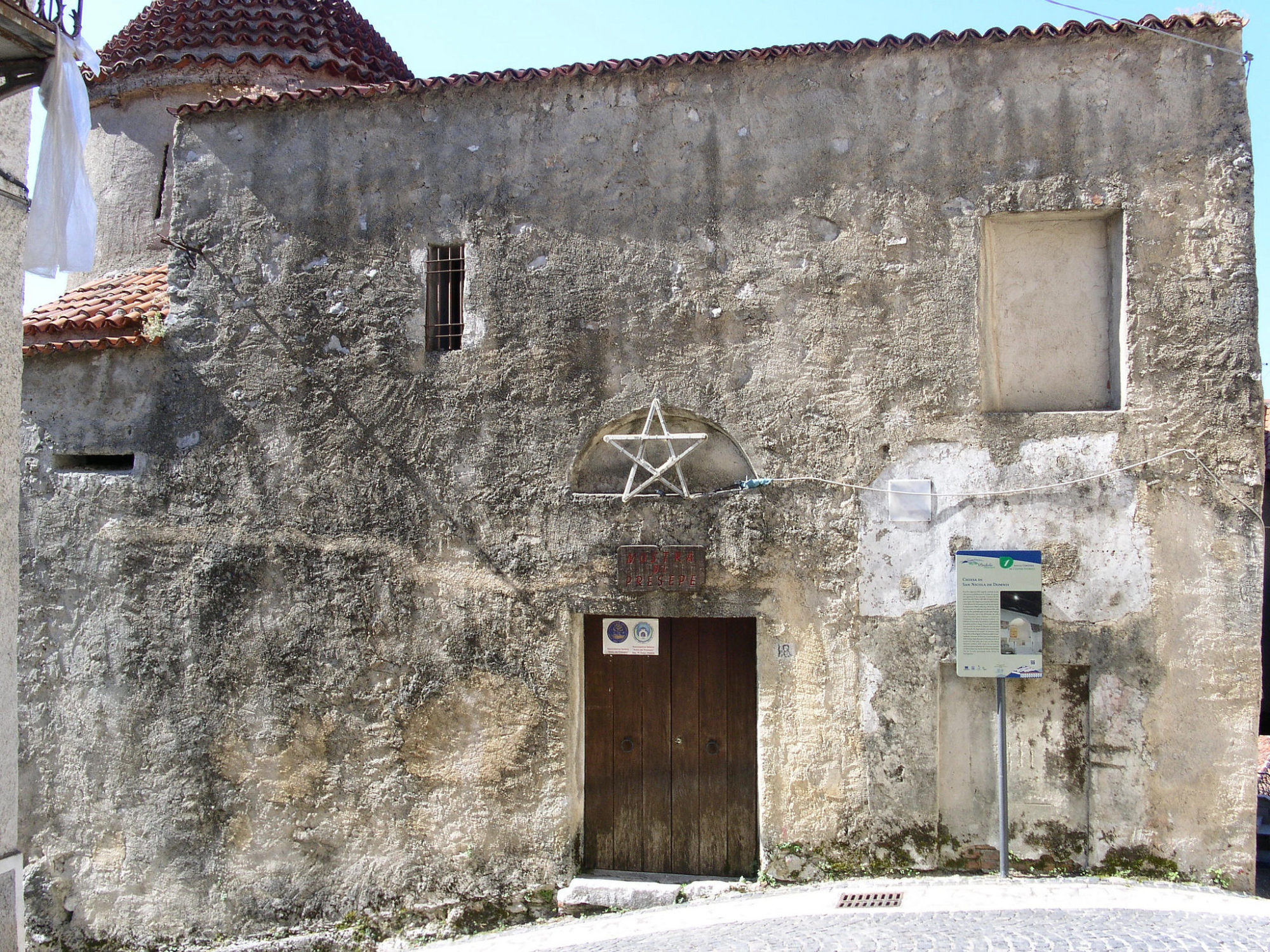
Chiesa S. Nicola De’ Domnis
Madonna della Civita [expander_maker id=”1″ more=”Leggi la Storia 🇮🇹 IT ” less=”Torna Su”]
La Storia
La data di fondazione di questo importante edificio religioso, è da ricercare in un lasso di tempo che va dal sesto al diciottesimo secolo dopo cristo. A quel periodo, infatti, risale la fondazione della cella trichora di San Nicola, un martirion legato all’espansione del monachesimo orientale i cui riti si affermarono definitivamente nell’ottavo secolo. Di difficile spiegazione è l’aggiunta del titolo “Dè Donnis”, eventualmente riconducibile alla presenza, a ridosso dell’edificio, di un istituto di accoglienza per fanciulle orfane e povere. Più probabile è l’accezione “de’ domnis”, cioè “di Signori”, che avrebbero avuto qualche peso rilevante nella storia della chiesa. Nulla sappiamo circa l’abbandono del rito orientale per quello occidentale; la presenza di tracce di affreschi con figure con particolari orientaleggianti databili al tredicesimo secolo, consente di affermare che per quel secolo e per molto tempo ancora, nella chiesa di San Nicola furono sicuramente celebrati riti secondo la tradizione greco-orientale. Tra l’ottavo ed il nono secolo alla trichora fu aggiunta un’aula rettangolare. Nel diciottesimo secolo l’altare più antico “a cofano” fu trasformato “ad amforem” secondo l’uso occidentale che si diffuse dopo il Concilio di Trento. Nel secolo precedente erano stati già murati, sempre per i motivi derivanti dal cambio di rito, un vano laterale aperto sulla destra della cella e due nicchie, nelle quali venivano riposti gli abiti sacri. Rispetto alle altre celle trichore, in quella padulese i tre corpi semicilindrici delle absi di si fondono formando una struttura omogenea e duratura. Si può, quindi, ritenere che non vi siano state grosse trasformazioni all’impianto originario, anche perché l’edificio poggia su roccia, il che l’ha sicuramente protetto da danni derivanti da movimenti tellurici. La cupola semisferica, impostata su un tamburo circolare, poggia sulle tre absi di semicircolari che la sostengono a mò di contrafforti, equilibrando la spinta. Il presbiterio si eleva rispetto al livello dell’aula e, come nelle antiche basiliche, un sedile basso in pietra segue la forma trilobata delle absi di: in quella mediana è collocato l’altare. La cripta sottostante il presbiterio a seguito di varie trasformazioni fu con ogni probabilità adibita a luogo di sepoltura. Lembi di affreschi sono visibili sulla parete sinistra della iconostasi, laddove è raffigurata la presentazione al tempio. Il ciclo era sicuramente più ricco: oggi sono distinguibili quattro personaggi dai nasi aquilini e dalle barbe accurate, in piedi ed in posizione frontale. Sulle pareti laterali dell’aula erano affrescate le teorie degli Apostoli e dei Santi; è oggi ancora leggibile la metà inferiore di una figura su fondo turchino, dal cui panneggio esce un piede calzato all’orientale di elegante fattura e dall’anatomia esasperata. Non c’è traccia di affreschi nel presbiterio. Provenienti dalla chiesa e attualmente conservate presso i depositi della Certosa si segnalano due statue lignee: il Cristo benedicente, attribuito alla bottega degli Alamanno (fine millequattrocento), mancante del braccio destro e della mano sinistra, e la Madonna delle Grazie, forse opera di Giovanni da Nola nel suo periodo giovanile, sedicesimo secolo.
[/expander_maker]
[expander_maker id=”3″ more=”read the story 
Santa Maria la Civita
St. Mary la Civita
SantaMaria la Civita may be the oldest church in Padula. In this area the people migrated from the ancient Roman town of Consilinum settled in the VIII-IX century. The early medioeval church was a basic construction with a curved absis, and with paintings on the walls.On the altar there was an image of the virgin Mary possibly a bas-relief or a wooden statue. The entrance has been moved from the western to the easter side of the building, and many more transformations have taken place, finally the buiding has been incorporated in a private house in 1784.
[/expander_maker]
_⏬ 💒 17 Casa Joe Petrosino 🇮🇹 IT - 🇬🇧 EN
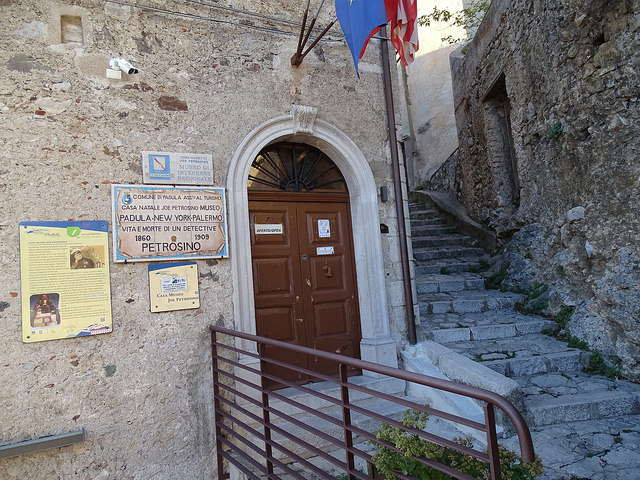
Casa museo J. Petrosino [expander_maker id=”1″ more=”Leggi la Storia 🇮🇹 IT ” less=”Torna Su”]
La Storia
Casa Museo Joe Petrosino
Giuseppe (Joe) Petrosino visse in questa casa fino a 13 anni, quando nel 1873 insieme al padre Prospero, sarto, e a tutta la famiglia “parti per l’America”, dove Giuseppe sarebbe diventato, poi, il grande, leggendario Joe, il poliziotto più famoso d’America. Dopo la partenza di Joe, alcuni suoi familiari furono fedeli custodi della sua residenza che, attraverso varie generazioni, ha conservato la memoria di quegli anni, nel susseguirsi delle molte partenze e dei pochi ritorni legati al sogno dell’emigrazione. La disposizione della casa, costruita nel 1768 poi ampliata nell’ 1834, gli arredi, gli oggetti, ci sono pervenuti quasi intatti. Qui vive la vicenda della grande emigrazione meridionale che si è dipanata dall’ultimo ‘800 fino ai primi del ‘900. Nel corso di questo periodo, le mutate condizioni della vita hanno comportato lievi trasformazioni che non hanno per nulla falsato la genuinità di questa testimonianza. Questa casa natale di Joe Petrosino, oltre al valore di documentazione storica legata al personaggio, può essere considerata una significativa e forse unica testimonianza della tipica casa degli emigranti di quegli anni: gli oggetti della loro esistenza, le loro abitudini, gli strumenti del loro lavoro, i bagagli delle loro partenze, si sono magicamente conservati tra queste mura. Per il Comune di Padula che, unitamente alla Regione Campania, ha contribuito alla realizzazione di questa casa-Museo, essa rappresenta un doveroso contributo nella lettura della storia dell’emigrazione e nell’attualizzazione delta vicenda dell’eroe Petrosino, che intuì la gravità del fenomeno mafioso, pagando con la vita la scoperta di assassini e mandanti dei primi delitti di mafia.
[/expander_maker]
[expander_maker id=”3″ more=”read the story 
Casa Museo Joe Petrosino
House Museum Joe Petrosino
This is the house where Giuseppe (Joe) Petrosino lived until he was 13 years old, the time (1873) when his father, the tailor Prospero, decided to emigrate to the United States. Joining the New York Police Department Petrosino become very famous as a detective for his relentless pursuit of Italian organized crime. The house is a unique example as it has all the original furniture and is a faithfull representation of l the life of the Padulese townsfolk at the end of the century, when many took the decision to cross the Ocean hoping for a better life in the United States.
[/expander_maker]
_⏬ 💒 18 S. Martino 🇮🇹 IT - 🇬🇧 EN

Chiesa di San Martino
[expander_maker id=”1″ more=”Leggi la Storia 🇮🇹 IT ” less=”Torna Su”]
La Storia
Chiesa di San Martino
L’antica parrocchia di San Martino è tra i monumenti più importanti di Padula, ubicata nel cuore dell’antico rione del Tuorno, documentata nel 1292, è una delle nove parrocchie annesse, nel 1498, alla chiesa matrice di San Michele Arcangelo e conserva quasi originaria la sua integrità primitiva. La pianta è composta da un’aula rettangolare con altare semicircolare orientato a sud, coperto da una struttura in materiale misto, con l’immagine dipinta di San Martino. Il soffitto è piano, la copertura è inclinata con falde ricoperte da tegole. L’antica sacrestia è dietro l’abside, nell’angolo sinistro. La facciata nuda presenta alcune edicole di Cosilinum. Ha un magnifico e splendido portale con gli stipiti adorni di volute, con cartiglio recante l’effigie di San Martino. L’ingresso è più alto rispetto al piano di cinque gradini. La struttura interna del tempio, austera e solenne, è a navata unica, con volta affrescata leggermente inclinata. E’ divisa in tre campate, sostenute da contrafforti e arconi, a sesto acuto, che reggono la copertura a due spioventi, con travature di carattere quattrocentesco. Il piccolo presbiterio è circondato da un coro ligneo del Cinquecento con sei stalli, opera di artigiani locali. La balaustra è in pietra di Padula così come l’altare maggiore della metà del XVIII secolo.
[/expander_maker]
[expander_maker id=”3″ more=”read the story 
Chiesa di S.Martino
St. Martin church
The Church was built before 1292, the date where documents register it, later (1498) being attached to the S. Michele Arcangelo Church. The entrance has a beautiful portal with the image of St. Martin . The façade has some niches probably taken from the ancient Roman city of Consilinum. The interior is rectangular, the absid half circular. The presbyter has a wooden choir with 6 seats, an artwork of local artisans . The altar is made in Padula stone.
[/expander_maker]
_⏬ 💒 18 S. Martino 🇮🇹 IT - 🇬🇧 EN

Chiesa di San Martino
[expander_maker id=”1″ more=”Leggi la Storia 🇮🇹 IT ” less=”Torna Su”]
La Storia
Chiesa di San Martino
L’antica parrocchia di San Martino è tra i monumenti più importanti di Padula, ubicata nel cuore dell’antico rione del Tuorno, documentata nel 1292, è una delle nove parrocchie annesse, nel 1498, alla chiesa matrice di San Michele Arcangelo e conserva quasi originaria la sua integrità primitiva. La pianta è composta da un’aula rettangolare con altare semicircolare orientato a sud, coperto da una struttura in materiale misto, con l’immagine dipinta di San Martino. Il soffitto è piano, la copertura è inclinata con falde ricoperte da tegole. L’antica sacrestia è dietro l’abside, nell’angolo sinistro. La facciata nuda presenta alcune edicole di Cosilinum. Ha un magnifico e splendido portale con gli stipiti adorni di volute, con cartiglio recante l’effigie di San Martino. L’ingresso è più alto rispetto al piano di cinque gradini. La struttura interna del tempio, austera e solenne, è a navata unica, con volta affrescata leggermente inclinata. E’ divisa in tre campate, sostenute da contrafforti e arconi, a sesto acuto, che reggono la copertura a due spioventi, con travature di carattere quattrocentesco. Il piccolo presbiterio è circondato da un coro ligneo del Cinquecento con sei stalli, opera di artigiani locali. La balaustra è in pietra di Padula così come l’altare maggiore della metà del XVIII secolo.
[/expander_maker]
[expander_maker id=”3″ more=”read the story 
Chiesa di S.Martino
St. Martin church
The Church was built before 1292, the date where documents register it, later (1498) being attached to the S. Michele Arcangelo Church. The entrance has a beautiful portal with the image of St. Martin . The façade has some niches probably taken from the ancient Roman city of Consilinum. The interior is rectangular, the absid half circular. The presbyter has a wooden choir with 6 seats, an artwork of local artisans . The altar is made in Padula stone.
[/expander_maker]
_⏬ 💒 19 S. Pietro Petroselli 🇮🇹 IT - 🇬🇧 EN
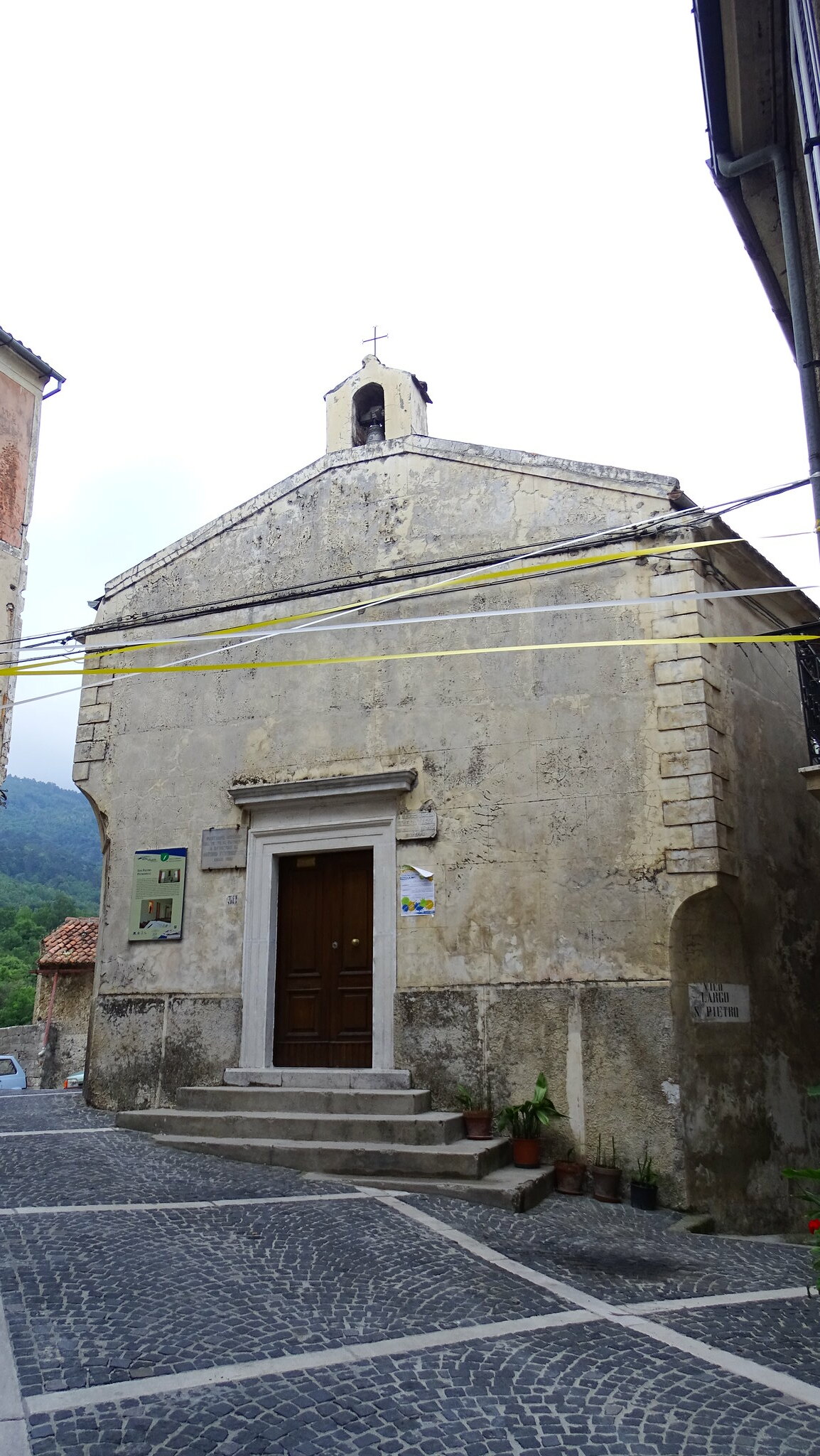
S. Pietro
[expander_maker id=”1″ more=”Leggi la Storia 🇮🇹 IT ” less=”Torna Su”]
Cappella di San Pietro Petroselli ( o San Pietro in Vinculis)
La chiesa è dedicata a San Pietro in catene ed è una delle parrocchie che nel 1498 fu annessa alla chiesa Madre di San Michele Arcangelo. E’ orientata, con la facciata principale, a nord del paese ed a sud verso il torrente Fabbricato, dove erano collocati i mulini. La chiesa è ricordata dalla tradizione locale come una delle parrocchie più antiche di Padula. Ha forma rettangolare con soffitto piano, senza abside, ha un piccolo campanile ed una sagrestia. L’interno è ad una sola navata, di austera semplicità. La facciata bella e sobria è stata rifatta in tempi recenti, il portale è del Cinquecento in pietra di Padula. L’area presbiteriale è stata ristrutturata ed è tutta in marmo. La volta affrescata, mostra arte e decoro nel rispetto della liturgia e della devozione. Presenta un piccolo transetto ed abside e due altari. Dietro al presbiterio è annessa la sacrestia, al lato corto è appoggiata una tribuna sorretta da due pilastri rettangolari con basamento, sulla quale era l’organo. La chiesa conserva due notevoli sculture lignee: San Pietro e San Paolo attribuite a Giovanni da Nola, del 1512.
[/expander_maker]
[expander_maker id=”3″ more=”read the story 
S. Pietro in vinculis
St. Peter in Vinculis
Among the oldest churches of Padula, it has a basic rectangular interior plant, with a clocktower and a sacristy.The façade has been renovated recently, as well as the presbyter in marmor. The portal (XVI cent.) is made of Padula stone. It has to wooden statues of the year 1512, St. Peter and St. Paul, attributed to Giovanni da Nola
[/expander_maker]
_⏬🚪 20 Porta dell'Oliva 🇮🇹 IT - 🇬🇧 EN
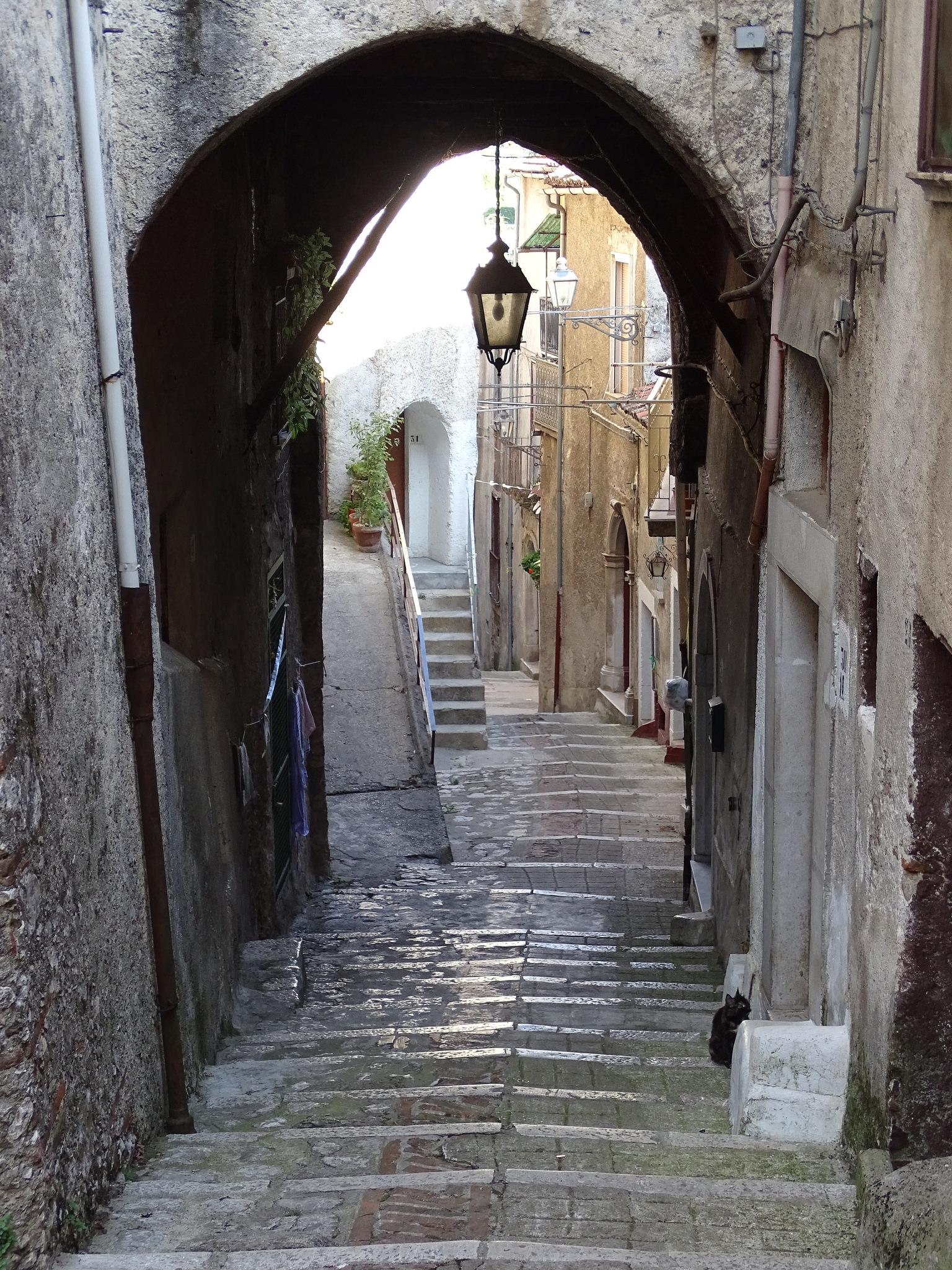
Porta dell’oliva
[expander_maker id=”1″ more=”Leggi la Storia 🇮🇹 IT ” less=”Torna Su”]
La Storia
Quasi certamente risalente al periodo medievale è, invece, l’altro accesso fortificato pervenuto fino a noi. Si tratta della cosiddetta “porta dell’Auliva” o “dell’Oliva” ne pressi della Chiesa di San Giovanni, nel rione Torno: un ampio sottoportico inquadrato da un arco gotico a sesto acuto. Altre porte di Padula, ricordate nel Seicento, erano: la “porta de petra lata”, il “portiello”, la “portella”, la “porta della derroita” e la “porta del Torno”.
[/expander_maker]
[expander_maker id=”3″ more=”read the story 
[/expander_maker]
_⏬ 💒 21 S. Giovanni 🇮🇹 IT - 🇬🇧 EN
[expander_maker id=”1″ more=”Leggi la Storia 🇮🇹 IT ” less=”Torna Su”]
La Storia
Chiesa di San Giovanni Battista
La chiesa di San Giovanni Battista era un’antica parrocchia nei pressi della porta dell’Auliva. Di notevole interesse storico, aveva preso il titolo del Battistero di San Giovanni in Fonti abbandonato nel IX secolo. Alla chiesa era annesso un cimitero, simbolo di riti arcaici funebri, che contrastava con l’uso occidentale che voleva le sepolture interne agli edifici sacri. La chiesa è stata ristrutturata rispettando l’antica configurazione. Ha una pianta rettangolare con piccola sacristia senza abside, una sola navata affiancata sul lato destro da una navatella con le cappelle di ius patronatus. La navata principale ha un bel soffitto piano e un arco a tutto sesto che circoscrive il presbiterio. Le pareti laterali sono decorate con pilastri ionici. La facciata esterna ha quattro pilastri dorici che sostengono il frontone. E’ formata da lesene che nascono su un alto basamento, sormontato da un ampio timpano. Al centro della facciata, la porta centrale. L’interno della chiesa è molto suggestivo, semplice e lineare, di grande valore spaziale, con soffitto a cassettoni e raccolto proprio per l’essenzialità della struttura formata da una ritmata successione di arcate a sesto acuto. Il presbiterio è rialzato di due gradini, l’altare maggiore è in pietra di Padula con la mensa, con due angeli reggifiaccole ai lati e due teste di puttini in marmo; sulla custodia il cervo e la colomba, più la figura dello Spirito Santo con due Angeli.
[/expander_maker]
[expander_maker id=”3″ more=”read the story 
S. Giovanni
St. John
the church of st. john took over the name of the baptistere of s. Giovanni in fonti in the valley which had been abandoned in the ix cent. Next to the church there was a cementery, unuasual for the local tradition of burial inside the church.the plant is rectangular , with one nave and a smaller one besides with some chapels. Along the walls there are ionic column,while the columns on the outer walls are of the doric type. The altar is of Padula stone.
[/expander_maker]
_⏬ 💒 23 S. Vito 🇮🇹 IT - 🇬🇧 EN
[expander_maker id=”1″ more=”Leggi la Storia 🇮🇹 IT ” less=”Torna Su”]
La Storia
Cappella di San Vito
Fu edificata nel 1747 per volere dell’Arciprete Matteo Caolo. Parzialmente inglobata in un palazzo gentilizio, vi si accede anche dall’esterno lateralmente attraverso un portale in pietra. La facciata ornata da lesene e capitelli ionici si conclude con un timpano in cima al quale è collocato il piccolo campanile a ventaglio. La piccola statua in pietra raffigurante il Santo posta sull’architrave del portale è attribuita alla mano del padulese Andrea Carrara, scultore affermato anche fuori dai confini del Vallo di Diano.
[/expander_maker]
[expander_maker id=”3″ more=”read the story 
S. Vito
St. Vito
The vS. Vito chapel was built in 1747 by the Head Priest Matteo Caolo. It is attached to a mansion, but can be accessed from the street as well. Above the portal there is small statue of stone of the saint, attributed to the stonecarver Andrea Carrara , a Padulese well known even beyond his native village.
[/expander_maker]
_⏬ 💒 25 Sacrario dei 300 🇮🇹 IT - 🇬🇧 EN
[expander_maker id=”1″ more=”Leggi la Storia 🇮🇹 IT ” less=”Torna Su”]
La Storia
Ossario dei Trecento
Quando i “rivoltosi” (quest’appellativo fu dato ai Trecento di Pisacane) giunsero a Padula, nella serata del 30 giugno 1857, apparve loro “mezza calzetta” (così i padulesi chiamavano S. Michele, il santo Patrono ), dicendo: <”Tornate indietro. Vi uccideranno”.
Questa leggenda, come tutte le fiabe nate dalla fantasia popolare, ha un particolare significato profetico per I’epilogo di quella che può ben definirsi I’eroica follia di Carlo Pisacane, precursore di Garibaldi, e di questi più grande, perche con la sua sfortunata impresa, gettò il seme nelle coscienze italiane dell’unità nazionale.
II motivo predominante che indusse Pisacane a dirigersi, dopo la delusione subita a Sapri, verso Padula fu la speranza di trovarvi ad attenderlo Antonio Santelmo ed il sacerdote Vincenzo Padula (in seguito eroi dei “Mille’).
La costante propaganda di redenzione, condotta per anni da questi due ardenti liberali, si era imposta oltre i confini di Padula, sino a raggiungere, messaggera di libertà e rivolta contro il dominio borbonico, i limitrofi paesi e la forte, generosa terra Cilentana.
Ma il destino fu avverso al biondo eroe di Sapri, infatti il Santelmo ed il Padula, unici amici sui quali poteva fare sicuro affidamento, erano il 30 giugno assenti. II primo nascosto nel Cilento per sfuggire alla cattura da parte dei borboni, ed il secondo detenuto nel carcere di Salerno. Perciò quando Pisacane giunse a Padula restò assai deluso per la glaciale, abulica accoglienza di alcuni notabili del luogo; trovò che nessun piano era stato precedentemente coordinato e questo grave errore fu la causa principale dell’insuccesso.
Egli aveva a lungo pensato e creduto che a Padula avrebbe trovato molte persone disposte ad assecondare i suoi disegni militari, che si proponevano soprattutto di iniziare da qui i moti insurrezionali.
Grazie al forte carattere di rivoluzionario e patriota, non si scoraggiò e, convinto che le grandi idee per trionfare hanno bisogno del supremo sacrificio, decise subito I’azione strategica da condurre, disponendo parte dei suoi uomini sul colle di S. Canione ed altri, alla spicciolata, in diversi punti della via Costa. In tal modo pensava di poter dominare facilmente ogni tentativo di offesa o resistenza dei gendarmi borbonici. Ma era ignaro del tradimento perpetrato ai suoi danni da tal Biase Grizzuti di Sala Consilina il quale, liberale prima indossò dopo per paura e viltà la divisa borbonica, rivelando al Comandante del Presidio borbonico di Sala, Colonnello Ghio, il piano strategico della spedizione. Le guardie urbane di Padula, oltre una sessantina, dopo il tradimento dei Grizzuti, ebbero ordine dal giudice regio locale, ligio ai Borboni, di sorvegliare i movimenti dei “rivoltosi”.
Nel frattempo la cavalleria borbonica, dopo avere oltrepassato con molta circospezione Ia montagna S. Michele di Sala, si avvicina lentamente alle spalle dei Trecento. Un banale incidente segnò I’inizio della tragedia.
Una guardia urbana, appostata a poche centinaia dì metri dalla colonna dei Pisacane, vedendo fuggire una lepre, sparò un colpo di fucile per ucciderla.
Le sentinelle della Spedizione, pensando che il colpo fosse stato sparato contro di loro, gridarono ai compagni di contraccare. II fuoco, sebbene lentamente, durò circa due ore e il Pisacane, credendo amiche le guardie urbane, intervenne per ordinare una tregua. E fu la fine. Perchè i Borbonici dei Colonnello Ghio, piombarono loro addosso da tutte le parti, Ii strinsero in un cerchio di fuoco. Il primo a cadere, mortalmente ferito, fu Ludovico dei Conti Negroni di Orvieto. Poi la fiumana borbonica si riverso sui Trecento animosi e li travolse, costringendo i superstiti a lasciare il terreno disseminato di cadaveri.
Con una poesia, ” La Spigolatrice di Sapri ” Luigi Mercantini alcuni anni dopo, rievocò quel fatale giorno (1° luglio 1857) .
I resti dei 59 caduti nella infausta giornata dei 1 luglio 1857 furono dignitosamente sistemati nella Chiesa dell’Annunziata a cura dell’Amministrazione Comunale di Padula.
[/expander_maker]
[expander_maker id=”3″ more=”read the story 
[/expander_maker]
_⏬ 💒 26 SS Annunziata 🇮🇹 IT - 🇬🇧 EN
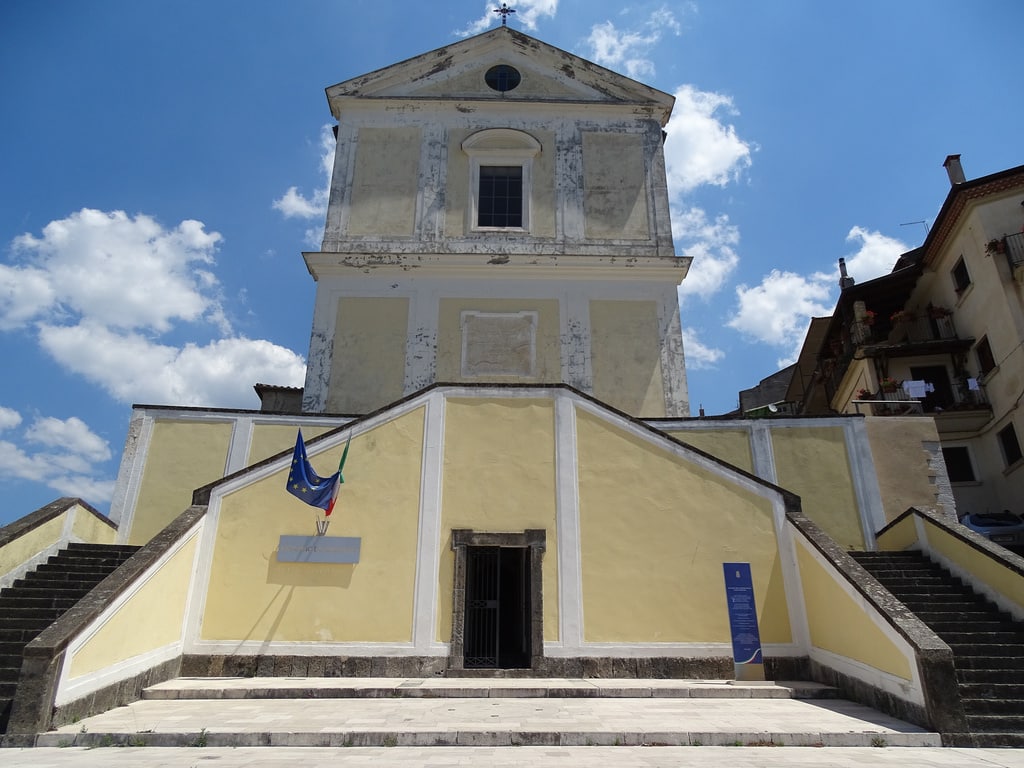
Chiesa SS. Annunziata
[expander_maker id=”1″ more=”Leggi la Storia 🇮🇹 IT ” less=”Torna Su”]
La Storia
Chiesa della SS. Annunziata
La visita pastorale che il vescovo di Capaccio effettuò a Padula nel 1619 costituisce il riferimento storico più antico legato alla chiesa. In quella cronaca viene citato anche l’ospedale annesso e un brefotrofio, soppressi poi probabilmente all’inizio del diciottesimo secolo. Ma altri fattori contribuirono certamente alla distruzione di quelle fabbriche: anzitutto il terremoto del 1857 e, successivamente, la costruzione della strada che da valle conduce alla sommità dell’abitato. Lavori, questi ultimi, che isolarono completamente la chiesa e che portarono alla demolizione della cappella di San Marco che si trovava poco più in basso dell’Annunziata e di cui è ancora visibile un affresco recentemente restaurato. Un primo totale rifacimento risale alla fine del Settecento, quando furono rialzati il tetto ed il soffitto; sulla parete est si notano ancora le precedenti finestrature poste più in basso rispetto alle attuali. Nel 1957, in occasione del Centenario della spedizione di Carlo Pisacane, al di sotto della chiesa fu costruito l’ossario contenente i resti di alcuni dei Trecento “giovani e forti”. All’ingresso della chiesa si accede attraverso una scala a doppia rampa; esso è inquadrato da un portale in pietra quattrocentesco che richiama quello della chiesa di Sant’Agostino. Sul lato ovest si trovano la sacrestia e la torre campanaria a pianta quadrata, con gli spigoli rinforzati in pietra. Sul versante opposto alla sua sede originaria è stato ricollocato il portale in pietra a grosse bugne con arco a tutto sesto che introduceva al cortile dell’ospedale; sulla chiave di volta dell’arco è sbalzata l’oca, simbolo di Padula. L’aula della chiesa, di forma rettangolare, coperta da una volta a sesto leggermente ribassato, presenta sei altari votivi sui due lati maggiori. Il presbiterio è rialzato di uno scalino rispetto all’aula e si conclude con un’abside poligonale.
[/expander_maker]
S. Annunziata
St. Annunziata
The church is first mentioned in a report of the visit to Padula of the Capaccio’s bishop in 1619. In the same document there is mention as well of an institute for orphans and destitute kids, along with a hospital. Those buildings were demolished following the damage they suffered in the 1857 earthquake and the construction of the road leading to the town. In the XVIII cent. The roof of church was raised, and traces of the old windows, lower than the present ones, can be recognized on the walls.the portal on the square in front of the church belonged to the demolished hospital , and has at the top a relief of a goose, symbol of Padula.
[expander_maker id=”3″ more=”read the story 
[/expander_maker]
_⏬ 💒 27 S. Vincenzo 🇮🇹 IT - 🇬🇧 EN
[expander_maker id=”1″ more=”Leggi la Storia 🇮🇹 IT ” less=”Torna Su”]
La Storia
Cappella di San Vincenzo
La cappella votiva fatta costruire dalla famiglia Caolo, è a forma rettangolare con portale di ingresso in pietra e presenta in cima alla semplice facciata, caratterizzata da un finestrone trilobato marcato da una fascia di intonaco in rilevato, la campana alloggiata in una piccola edicola in muratura. L’aula coperta da una volta a sesto ribassato ospita un organo settecentesco a canne, un’edicola con la statua lignea del Santo e una tela ottocentesca che raffigura l’ascensione della Vergine, posta sopra l’altare in pietra di Padula. La semplicità dell’esterno cela la ricchezza e la cura nei particolari delle decorazioni a stucco dell’aula, dove la presenza di fregi e di motivi scultorei ed allegorici rendono questa cappella un unicum tra le altre fabbriche coeve esistenti nel paese.
[/expander_maker]
[expander_maker id=”3″ more=”read the story 
S. Vincenzo
St. Vincent
The S. Vincenzo Chapel was built by commission of the Caolo family. It has a rectangular plant, and houses a wooden pipe organ , a wooden statue of Saint Vincent and a painting of the Acension of the Virgin Mary to heaven, placed above the altar in the local Padula stone. The very unassuming exterior hides the richly stuccoed and decorated interior, that makes this chapel stand out among the Padulese religious buildings.
[/expander_maker]
_⏬ 🚪 28 Portale in pietra 🇮🇹 IT - 🇬🇧 EN
[expander_maker id=”1″ more=”Leggi la Storia 🇮🇹 IT ” less=”Torna Su”]
La Storia
La pietra di Padula e i portali
La Certosa di Padula ha avuto nei secoli un’importanza determinante nella vita socio-economica di Padula soprattutto perché essendo stata un cantiere perenne ha inciso profondamente nel diffondersi di attività artigianali e manuali tra le genti locali. Alla metà del XIX secolo si contavano 505 artigiani e tra essi 35 muratori, 3 tagliapietre e soprattutto 240 scalpellini: un esercito di addetti alla lavorazione della pietra che hanno lasciato testimonianze della loro opera anche fuori del territorio del Vallo di Diano e dell’Italia stessa. Le cave dalle quali proveniva la materia prima erano diverse; le due più importanti sono quella del Tempone e quella della Serra. La “pietra di Padula” è un’arenaria calcarea (calcarenite) fossilifera dal colore bianco avorio con piccolissimi granuli scuri, in termini locali detti “pulci”, i quali sovente si presentano sotto forma di vere e proprie macchie e determinano un grosso spreco di materiale per selezionarne del pregiato. La sua pastosità, a fronte della sua durezza, ne conserva la lavorabilità scultorea che nei secoli si è manifestata dalle opere d’arte nella Certosa ai manufatti e agli elementi decorativi sparsi in tutte le case di Padula: vasi, mortai, architravi, ornie, soglie lavorate e con portavasi laterali figurati e soprattutto portali di abitazioni e di edifici religiosi. Per avere un’idea fedele della bellezza di tali opera basterà fare una passeggiata nel cuore del centro storico dove tutti questi splendidi manufatti perpetuano il fascino di un’epoca passata e di attività manuali che oggi forse appaiono irreali. Vale la pena soffermarsi tra tutti i mastri scalpellini di cui si ha memoria nel Settecento ( Giuseppe Brigante, Pietro Cavolo, Giuseppe Morra, Lorenzo Marino, Francesco Moscarella, ecc.) sul nome di Andrea Carrara cui vanno attribuiti nella Certosa di San Lorenzo, oltre ad alcune metope della trabeazione del Chiostro Grande, i busti degli Evangelisti, della Vergine con Bambino e di S. Anna e la Vergine posti sul secondo ordine di finestre della facciata; egli ha lasciato, tra l’altro, in Padula le statu di San Vito sulla facciata dell’omonima cappella, di una Madonna con Bambino e di un San Michele nella cappella del Monte Romito. Lo stesso ha firmato nel presbiterio della chiesa madre dell’Assunta di Sanza i busti di un San Giuseppe con Bambino, di un San Pietro e di un San Paolo, probabili residue testimonianze di un ciclo più vasto, e il portale della Chiesa di San Zaccaria a Brienza, città dove morì il 28 agosto 1757
[/expander_maker]
[expander_maker id=”3″ more=”read the story 
[/expander_maker]
_⏬ 💒 29 S. Paolo 🇮🇹 IT - 🇬🇧 EN
[expander_maker id=”1″ more=”Leggi la Storia 🇮🇹 IT ” less=”Torna Su”]
La Storia
Cappella di San Paolo
“Questa chiesa è ubicata nella contrada detta ‘San Paolo’. Confina con al strada pubblica ed è unita alla chiesa dell’Annunziata”, così Giulio II scriveva nella sua bolla d’unione spedita nell’anno 1507.
Nella chiesa ci sono due altari, uno di rimpetto alla porta, con quadro di pittura sopra tela della Conversione di San Paolo, con cornice indorata. Nella parte di destra vi è quello del Crocifisso, con l’immagine di legno, con accasamento di tavole dipinte. Ha il palliotto vecchio di damasco bianco, due candelieri di legno e carta di gloria. Sopra l’altare vi è il guardiapolvere di legno dipinti. Sopra la porta vi è una campana mezzana, dietro la porta la fonte per l’acqua santa. Nel pavimento vi è una sepoltura, e vi è ancora un campanello per la messa.
[/expander_maker]
[expander_maker id=”3″ more=”read the story 
Cappella di S. Paolo
St. Paul Chapel
The church is mentioned in a letter signed by Pope JuliusII in 1507. It has two altars, one facing the entrance with a painting picturing St. Paul’s conversion, the second on the right hand with a wooden Crucifix.The antependium, or altar frontal of the first altar is made of ancient white damask tiss
[/expander_maker]
_⏬ 💒 30 Cappella S. Antonio 🇮🇹 IT - 🇬🇧 EN

Chiesetta di S: Antonio
[expander_maker id=”1″ more=”Leggi la Storia 🇮🇹 IT ” less=”Torna Su”]
Cappella di Sant’Antonio Abate
La graziosa chiesetta intitolata a Sant’Antonio Abate è un vero gioiello, un tesoro di fede e di arte. Sorge nel centro storico, nella piazzetta di “San Paolo ai Fossi” La struttura originaria del sacro edificio è stata trasformata più volte e i restauri ne hanno modificato l’originalità. La chiesa presenta una forma rettangolare a navata unica. L’esterno, modesto nelle sue linee architettoniche, presenta un caratteristico campanile con una campanella. Nella parte retrostante ha un’abside semicircolare che sporge sul lato opposto della facciata. Il lato costeggiante la strada presenta tre contrafforti. Il presbiterio è elevato di un gradino ed è delimitato da una balaustra che è caratterizzata da ricchezza di marmi e finezza d’intonaco. La facciata ha due registri, quello inferiore di gusto neogotico fiorito veneziano, quello superiore è ionico. Si conclude più in alto della copertura con un timpano acuto al cui centro è posto un falso rosone. Il portale in stile neogotico è elegantemente scolpito e impreziosito da vari fregi, affiancato da due colonne tortili, sulle quali vi sono due edicole a guglia , con santi. Ai lati del portale, due bifore ogivali, con colonnina centrale tortile e volta a sesto acuto. L’altare ha ai suoi lati due nicchie con le immagini di San Pio e Maria Santissima di Pompei. La balaustra è in marmo policromo mentre l’abside ha un effetto scenico. All’ingresso una piccola acquasantiera in pietra di Padula. Le modanature e le decorazioni del Settecento che ornano l’altare, le nicchie, le finestre e le varie cornici sono in stucco.
[/expander_maker]
[expander_maker id=”3″ more=”read the story
[/expander_maker]
_⏬ 💒 30-A Monumento Caduti 🇮🇹 IT - 🇬🇧 EN

[expander_maker id=”1″ more=”Leggi la Storia 🇮🇹 IT ” less=”Torna Su”]

La Storia
Autore Pirolo Torelli Donato – Solofra 1877 / Napoli 1974
Costruito nel 1930
Materia tecnica : Pietra e bronzo fuso
Descrizione:
Monumento complesso costituito da una base quadrangolare in pietra sulla quale poggia un basamento in marmo articolato in sporgenze e rientranze su alcune delle quali sono fissate le lapidi con gli elenchi dei caduti della prima e seconda guerra mondiale. Sul basamento è sovrapposta un’alta stele in pietra su base in marmo, quest’ultima presenta, sul lato anteriore, l’epigrafe tra due corone di alloro. La stele sul prospetto principale ha un rilievo in bronzo raffigurante una Vittoria alata che tiene nella mano destra un tralcio di rosa e nella sinistra un ramo di palma. Ai suoi piedi la statua di un fante morto che ancora stringe una bomba. Sul lato posteriore un’aquila bronzea poggia gli artigli su una bomba coperta da una bandiera e da un ramo di quercia. Alle spalle del rapace un ramo di palma ed una stella entrambi in bronzo. Il monumento è posto in un’aiuola circolare delimitata da un’elaborata ringhiera in ferro.
Indicazioni sul soggetto
Allegorie-simboli: Vittoria alata; aquila. Figure maschili: fante.
Notizie storico-critiche
Il gruppo scultoreo della Vittoria, che del bozzetto in deposito presso il Museo di San Martino (NA) conserva la tensione spirituale, unisce nella continuità plastica gli elementi simbolici e realistici della Patria e del caduto. Del resto Donato Torelli, cui l’opera è documentata, fu nipote e poi figlio adottivo dell’eclettico intellettuale Achille (1841/ 1922), giornalista, scrittore e celebre bibliotecario della Biblioteca Nazionale di Napoli. Inaugurato nel 1930, del monumento sussiste impressa la memoria, raccolta nelle testimonianze locali, delle difficoltà ingenti di trasportare il massiccio blocco carsico, simbolo dei luoghi e cimelio delle trincee. Al termine del secondo conflitto mondiale fu aggiunta l’epigrafe con i nomi di quei caduti.
Proprietà Ente pubblico territoriale
Comune di Padula
[/expander_maker]
[expander_maker id=”3″ more=”read the story 
[/expander_maker]
_⏬ 🚪 31 Porta di S. Antonio 🇮🇹 IT - 🇬🇧 EN
[expander_maker id=”1″ more=”Leggi la Storia 🇮🇹 IT ” less=”Torna Su”]
La Storia
La porta di Sant’Antonio
La porta di S. Antonio nei pressi di Piazza Umberto I, unica sopravvissuta della parte alta del paese, nella veste che è pervenuta fino a noi, risale come impianto al XVI secolo: portale in bugnato con arco a tutto sesto che riporta all’imposta la figura dell’oca, simbolo del paese e dell’antica istituzione comunale “Universitatis terrae Padulae”. Quasi certamente risalente al periodo medievale è, invece, l’altro accesso fortificato pervenuto fino a noi. Si tratta della cosiddetta “porta dell’Auliva” o “dell’Oliva” ne pressi della Chiesa di San Giovanni, nel rione Torno: un ampio sottoportico inquadrato da un arco gotico a sesto acuto. Altre porte di Padula, ricordate nel Seicento, erano: la “porta de petra lata”, il “portiello”, la “portella”, la “porta della derroita” e la “porta del Torno”.
[/expander_maker]
[expander_maker id=”3″ more=”read the story 
S. Antonio Porta
St. Antonio Gate
The S. Antonio gate is the only surviving gate in the walls that encircled Padula in the Middle Age.At has undergone some transformation and the present form belongs to the XVI century.The bossage style arch has on the top the image of the goose symbol of Padula. Other 6 gates in the defensive walls are still remember by their names, but their actual location has not been determined (yet).
[/expander_maker]
_⏬ 🚪33 Portale del 1500 🇮🇹 IT - 🇬🇧 EN
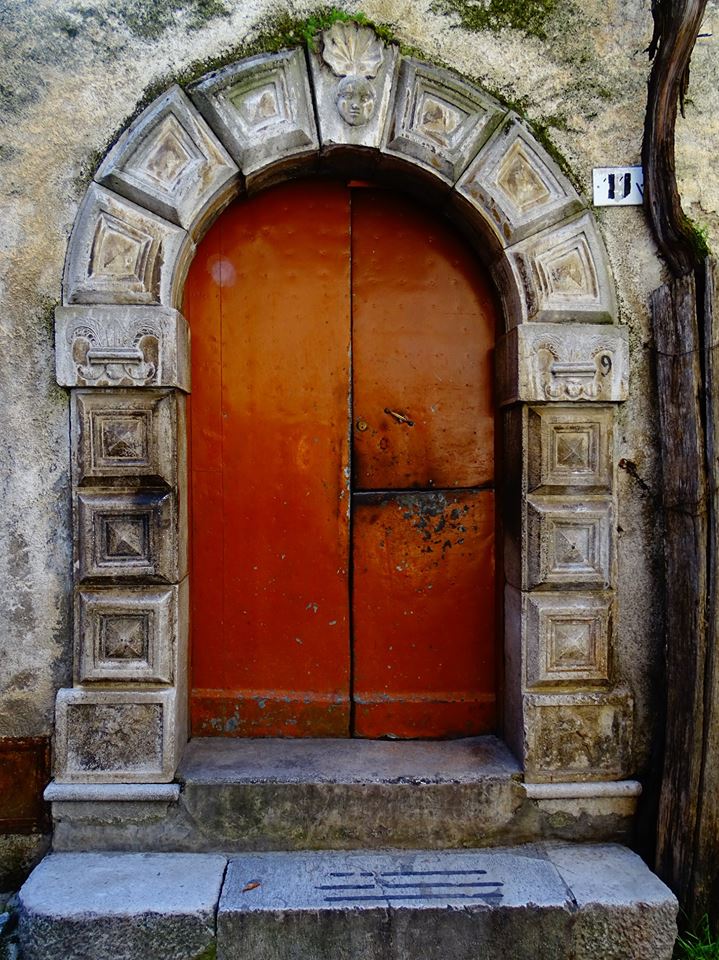
Portale in Pietra di Padula, del XV secolo
[expander_maker id=”1″ more=”Leggi la Storia 🇮🇹 IT ” less=”Torna Su”]
La Storia
La pietra di Padula e i portali
La Certosa di Padula ha avuto nei secoli un’importanza determinante nella vita socio-economica di Padula soprattutto perché essendo stata un cantiere perenne ha inciso profondamente nel diffondersi di attività artigianali e manuali tra le genti locali. Alla metà del XIX secolo si contavano 505 artigiani e tra essi 35 muratori, 3 tagliapietre e soprattutto 240 scalpellini: un esercito di addetti alla lavorazione della pietra che hanno lasciato testimonianze della loro opera anche fuori del territorio del Vallo di Diano e dell’Italia stessa.
Le cave dalle quali proveniva la materia prima erano diverse; le due più importanti sono quella del Tempone e quella della Serra. La “pietra di Padula” è un’arenaria calcarea (calcarenite) fossilifera dal colore bianco avorio con piccolissimi granuli scuri, in termini locali detti “pulci”, i quali sovente si presentano sotto forma di vere e proprie macchie e determinano un grosso spreco di materiale per selezionarne del pregiato. La sua pastosità, a fronte della sua durezza, ne conserva la lavorabilità scultorea che nei secoli si è manifestata dalle opere d’arte nella Certosa ai manufatti e agli elementi decorativi sparsi in tutte le case di Padula: vasi, mortai, architravi, ornie, soglie lavorate e con portavasi laterali figurati e soprattutto portali di abitazioni e di edifici religiosi. Per avere un’idea fedele della bellezza di tali opera basterà fare una passeggiata nel cuore del centro storico dove tutti questi splendidi manufatti perpetuano il fascino di un’epoca passata e di attività manuali che oggi forse appaiono irreali. Vale la pena soffermarsi tra tutti i mastri scalpellini di cui si ha memoria nel Settecento ( Giuseppe Brigante, Pietro Cavolo, Giuseppe Morra, Lorenzo Marino, Francesco Moscarella, ecc.) sul nome di Andrea Carrara cui vanno attribuiti nella Certosa di San Lorenzo, oltre ad alcune metope della trabeazione del Chiostro Grande, i busti degli Evangelisti, della Vergine con Bambino e di S. Anna e la Vergine posti sul secondo ordine di finestre della facciata; egli ha lasciato, tra l’altro, in Padula le statu di San Vito sulla facciata dell’omonima cappella, di una Madonna con Bambino e di un San Michele nella cappella del Monte Romito. Lo stesso ha firmato nel presbiterio della chiesa madre dell’Assunta di Sanza i busti di un San Giuseppe con Bambino, di un San Pietro e di un San Paolo, probabili residue testimonianze di un ciclo più vasto, e il portale della Chiesa di San Zaccaria a Brienza, città dove morì il 28 agosto 1757.
[/expander_maker]
[expander_maker id=”3″ more=”read the story 
Portale del 1500
Portal of the XV cent.
The Padula Charterhouse with its size and maintenance requirements has permanently employed many artisans, that have left part of their works in the village as well. In the middle of the XIX century there were 35 masons, 3 stonecutters and 240 stonecarvers.Their works can be found all over the province and beyond.
The 2 main caves where the stones were extracted are those of Tempone and Serra.
The Padula stone has an ivory white colour, with sometimes black clumps that may have a relatively bigger size, so that much stone goes wasted in order to have a purely white piece. It is a hard stone but relatively easy to be worked, and many works can still be found in the village: vases, mortars, lintels,portals of private residences and churches.
[/expander_maker]
_⏬ 💒 34 Cappella Del Carmelo 🇮🇹 IT - 🇬🇧 EN

[expander_maker id=”1″ more=”Leggi la Storia 🇮🇹 IT ” less=”Torna Su”]
La Storia
Cappella della Madonna del Carmelo
Di forma quadrata, è rialzata rispetto al piano dell’attuale Corso Garibaldi. Il portale in pietra è sormontato da una piccola edicola con affresco raffigurante la Vergine con Bambino. Un campaniletto si erge alla sommità del tetto a capanna. Nell’interno la piccola aula è coperta da una volta a crociera e le decorazioni e le modanature sono realizzate in stucco. Sull’altare, molto semplice, sollevato di uno scalino rispetto al piano dell’aula, è presente una tela settecentesca raffigurante la Madonna con Bambino fra due Santi inginocchiati. Si segnala di fronte alla cappella, murato sulla facciata di un’abitazione privata “ un frammento di bassorilievo in calcare (…) Rappresenta tre episodi della Genesi, in figurazione continua: il Peccato originale a sinistra, a destra il Sacrificio di Isacco; la scena centrale è composta da due figure maschili, togate e reggenti in mano un rotolo, con una donna discinta inginocchiata dinanzi, e forse rammentano l’incontro di Sara, moglie di Abramo, coi Messi divini, i quali venivano ad annunziarle che sarebbe stata madre” (Tortorella)
[/expander_maker]
[expander_maker id=”3″ more=”read the story 
Chapel of our Lady of Mount Carmel
The Chapel has a square plant, and overlooks the Corso Garibaldi. The stone portal is crowned by a shrine with a fresco of the Blessed Virgin with the Infant Jesus,A small clocktower sits atop of the thatched roof. Inside the small room is covered by a cross vaulted ceiling,with stuccoed decorations on the walls.On the altar there is a XVIII cent. Painting with the Virgin Mary with Infant Jesus and two Saints.
Outside, across the backstreet, on the wall of a private house, there is a fragment of bas-relief depicting three episodes from the Genesis book of the Bible: the original Sin on the left, Isaacs sacrifice on the right, and the scene at the center may represent Sara meeting the heavenly messengers announcing her the maternity.
[/expander_maker]

_⏬ 💒 05 S.Giacomo
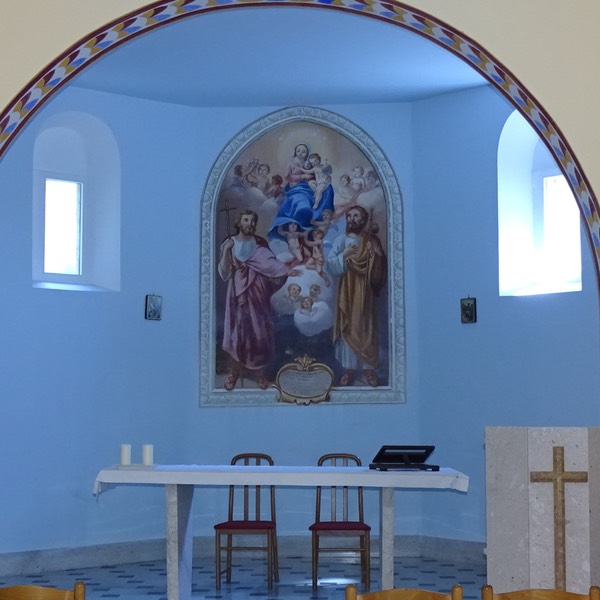
Cappella S. Giacomo
_⏬ 💒 06 Conv. S. Francesco
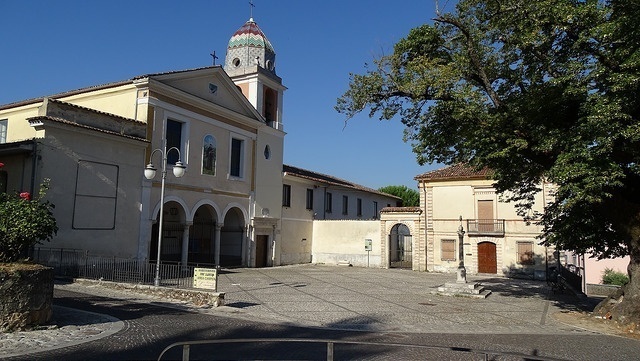
Convento S.Francesco

_⏬ 🏞 02 Parco del Cosilinum

Mura ciclopiche
_⏬ 💒 03 S. Sepolcro

Chiesa S. Sepolcro
_⏬ 💒 05 Monte Romito
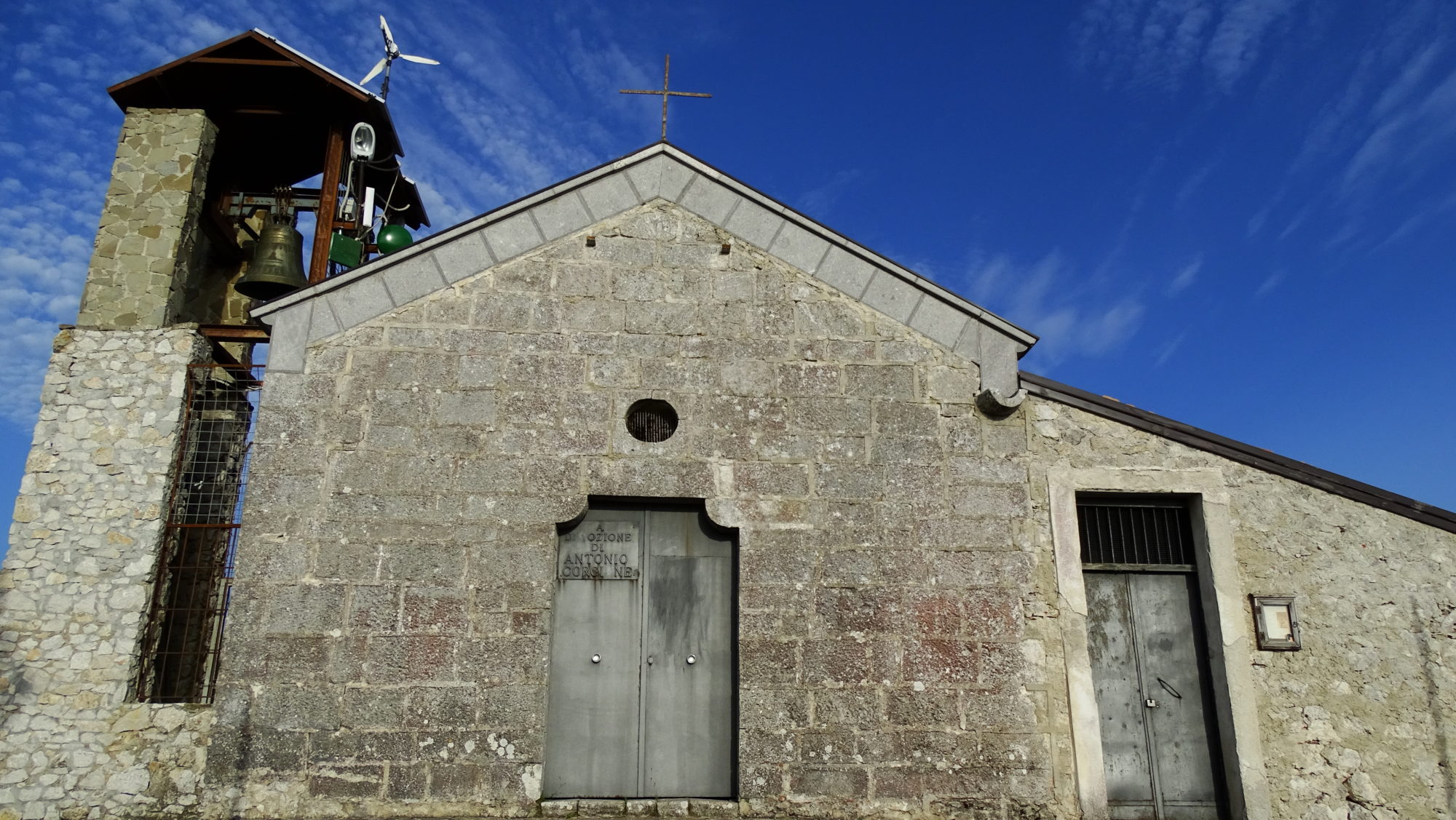
Della cappella non si conosce l’anno di fondazione, ma dovrebbe essere precedente al XVII secolo, come sembrerebbe indicare la struttura architettonica il portale. Probabilmente fu eretta dai pastori che frequentavano la zona dedicata al culto della vergine.
L’interno, a navata unica, ospita un bell’altare in pietra di Padula sormontato da un’immagine in stucco della Vergine in trono su di una nuvola. Le statue del crocifisso e della Madonna dell’atte (più probabilmente una raffigurazione di Santa Barbara) che solitamente si trovano nella chiesa di San Giovanni Battista.
Durante la prima domenica di maggio e la terza di settembre viene portata in processione dalla chiesa della SS Annunziata la statua lignea in una teca di legno dorato e vetro, la statua della Madonna su un camion addobbato che, seguito dai fedeli in auto, raggiunge la località Monte Romito, antico Santuario Mariano a 1380 m.s.m, dopo aver attraversato la località Boccaglie di Mandrano. Alla processione seguono il rito religioso, colazioni all’aperto stando all’ombra di faggi secolari, La dal quale si può ammirare il bellissimo panorama del Vallo di Diano, in primo piano fa da padrona la meravigliosa Certosa di San Lorenzo, .. In settembre, seguendo il percorso inverso, la statua della Madonna fa ritorno in parrocchia.

